Romanticism Exhibition
234 Matches
-
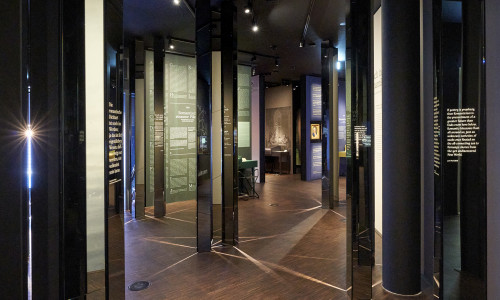 2F
2FIntroduction to the 2nd floor
Romantic awakening
“The mysterious path leads within”
-

CLEMENS BRENTANO
Letter to Karoline von Günderrode, Marburg, mid-May 1802
-
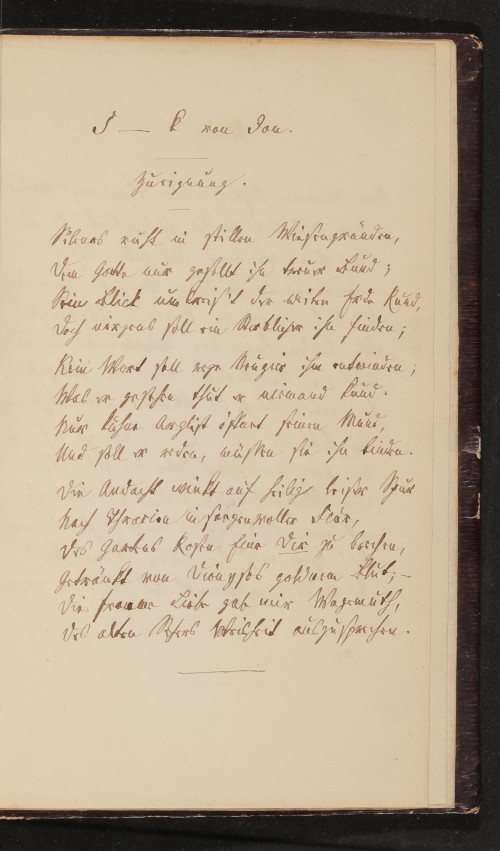
Writings, both finished and unfinished
Wall display case
-
 2F
2FRomantically lonely places
Wackenroder and Tieck in the Harz Mountains (1794)
-
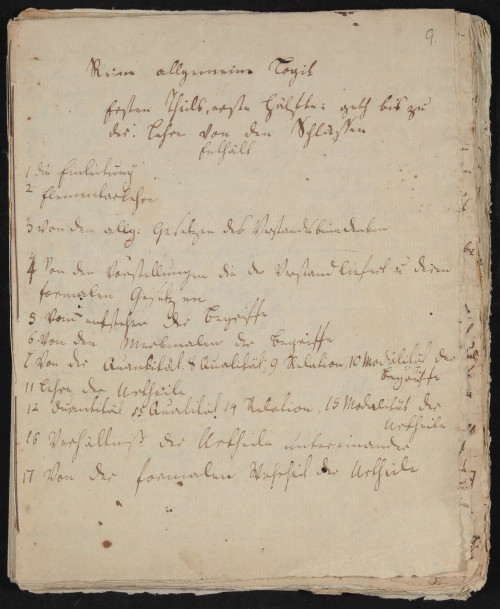
Youth and Family
Display case 1
-
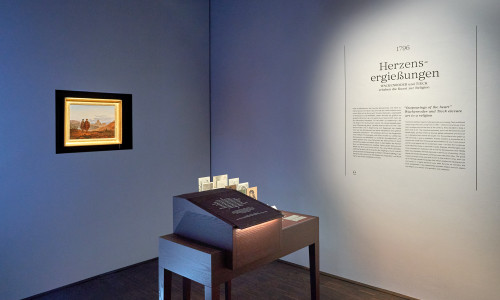 2F
2FOutpourings of the heart
Wackenroder and Tieck elevate art to a religion (1797)
-
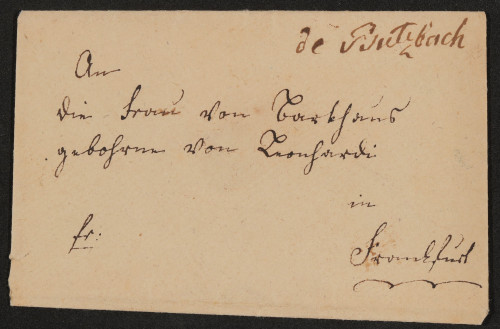
Sociability among Frankfurt Patricians
Display case 2
-
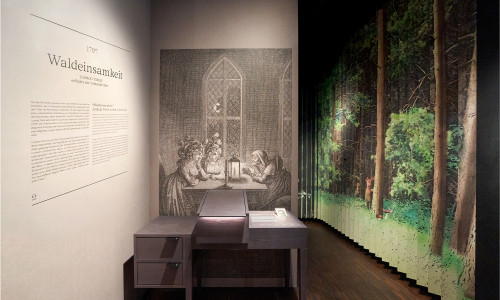 2F
2FWaldeinsamkeit
Ludwig Tieck writes a folk tale (1797)
-
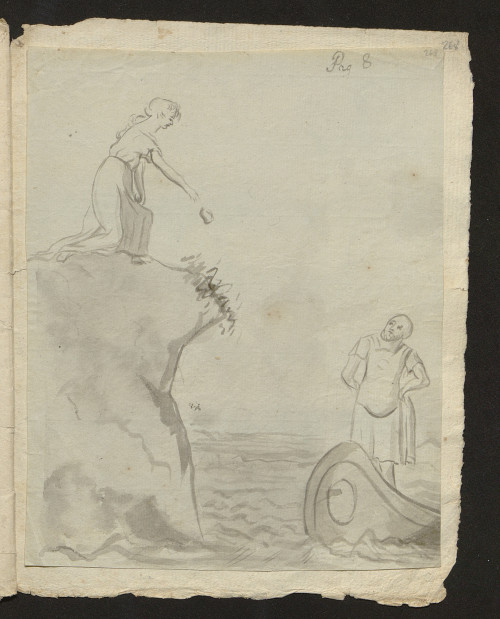
Literary Work
Display case 3
-
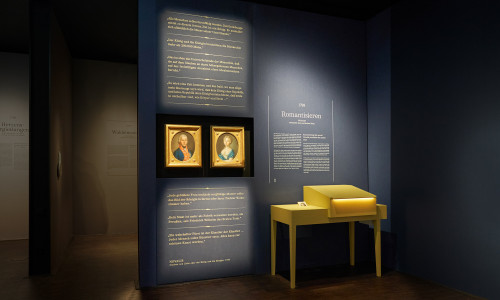 2F
2FRomanticizing the world
Novalis proclaims the poetic state (1798)
-
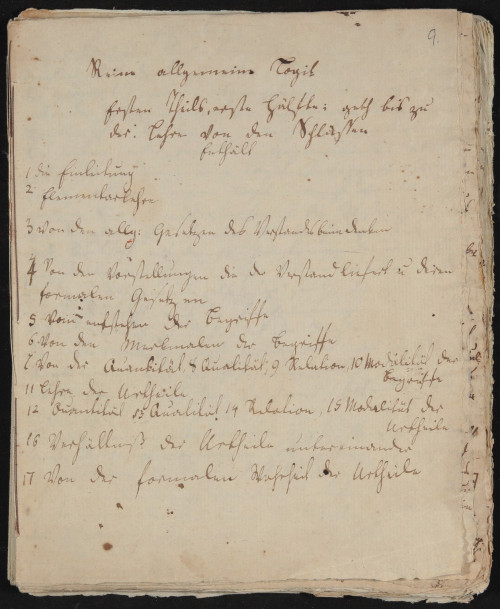
Philosophical Studies
Display case 4
-
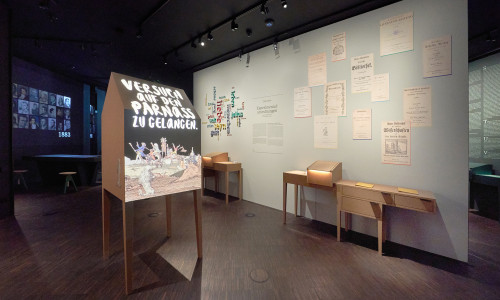 2F
2FExperimental arrangements
The Schlegels cause a sensation (1798)
-
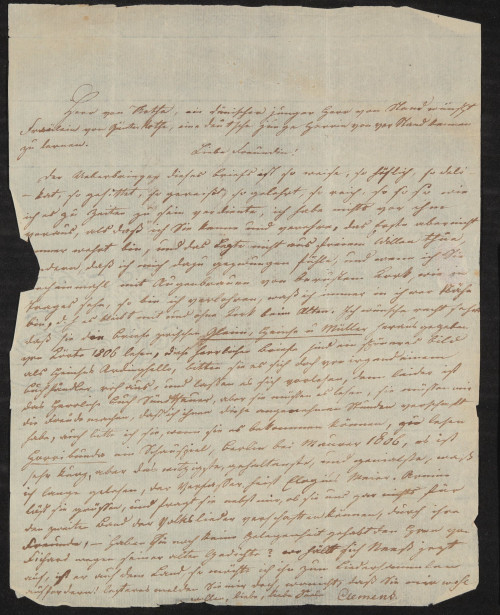
Literary Collaboration in Romanticism
Display case 5
-
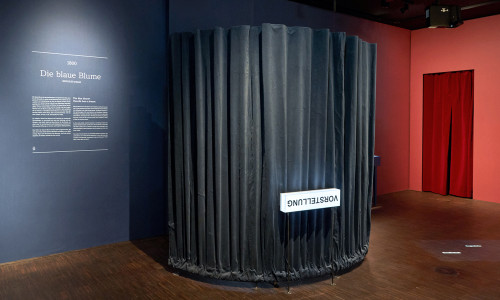 2F
2FThe blue flower
Novalis has a dream (1800)
-
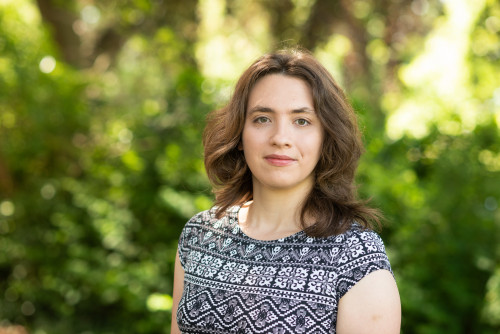
The curator
-
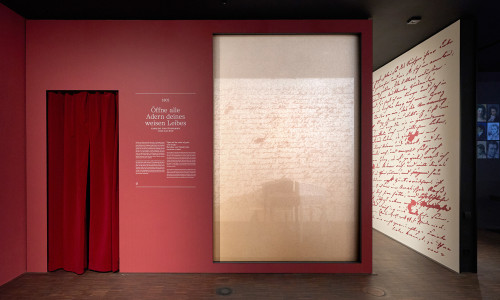 2F
2FOpen all the veins of your wise body
Karoline von Günderrode receives a letter (1802)
-
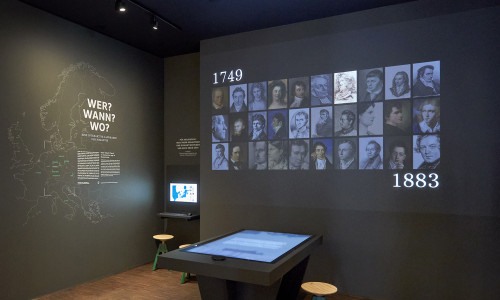 2F
2FWho? When? Where?
Who? When? Where? — An interactive map of Romanticism
-
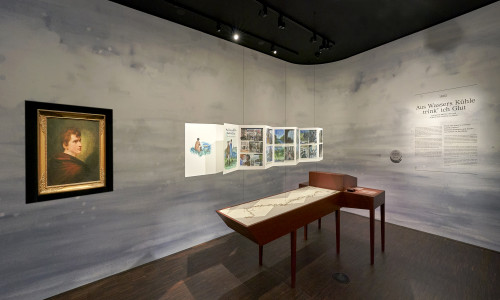 2F
2FFrom the water’s coolness I drink embers
Clemens Brentano and Achim von Arnim on the Rhine (1802)
-
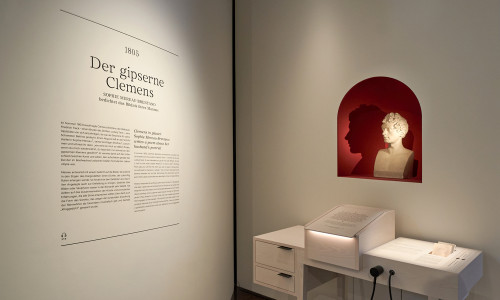 2F
2FClemens in plaster
Sophie Mereau-Brentano writes a poem about her husband’s portrait (1803)
-
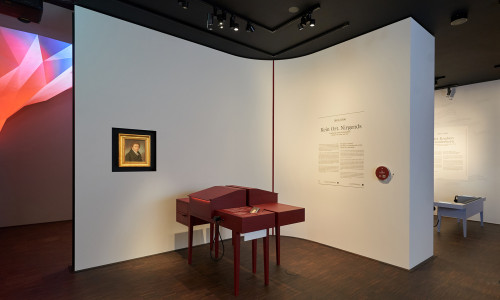 2F
2FNo place on earth
Karoline von Günderrode writes about love and death (1805/1806)
-
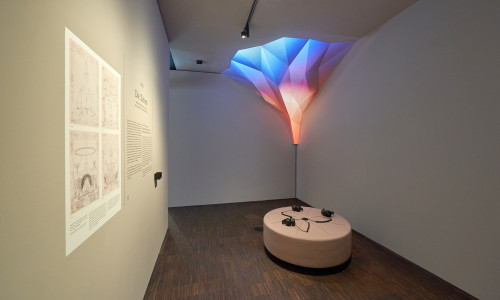 2F
2FThe Times of Day
Philipp Otto Runge plans a Romantic synthesis of the arts (1805)
-
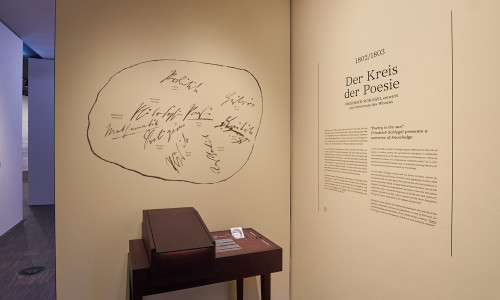 2F
2FPoetry is the sun
Friedrich Schlegel presents a universe of knowledge (1802/1803)
-
 2F
2FThe Boy’s Magic Horn
Achim von Arnim and Clemens Brentano collect folk songs (1805-1808)
-
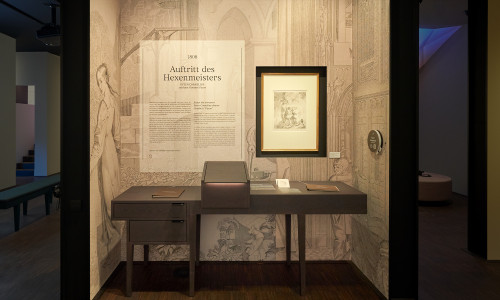 2F
2FEnter the sorcerer
Peter Cornelius draws Goethe’s “Faust” (1808)
-
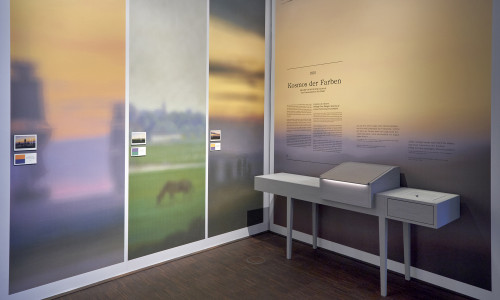 2F
2FCosmos of colours
Philipp Otto Runge’s theory of colour harmony for painters (1810)
-
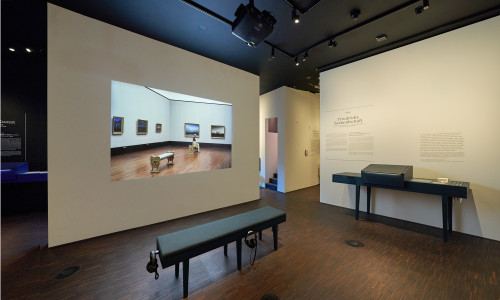 2F
2FFriedrich’s seascape
Clemens Brentano and Achim von Arnim visit an exhibition (1810)
-
 2F
2FPhysics as art
Johann Wilhelm Ritter works with electricity and light (1797-1810)
-
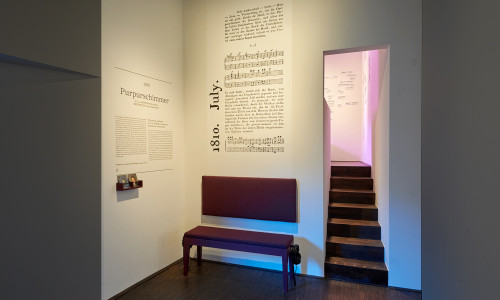 2F
2FThe purple shimmer
E. T. A. Hoffmann declares Beethoven a Romantic (1810)
-
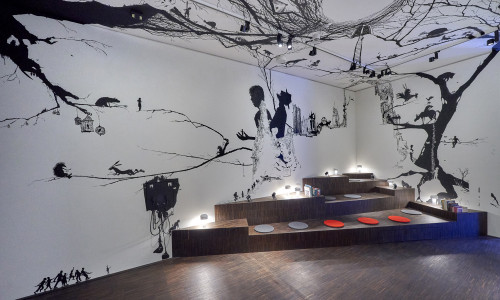 2F
2FAnd they lived happily ever after
Jacob and Wilhelm Grimm collect fairy tales (1812)
-
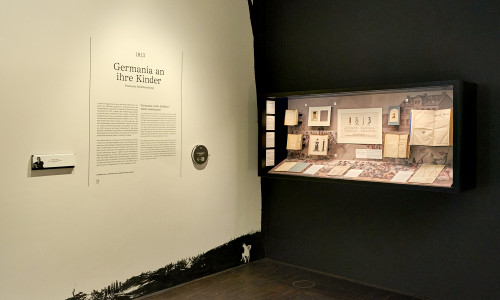 2F
2FGermania to Her Children
Poetic mobilization (1813)
-
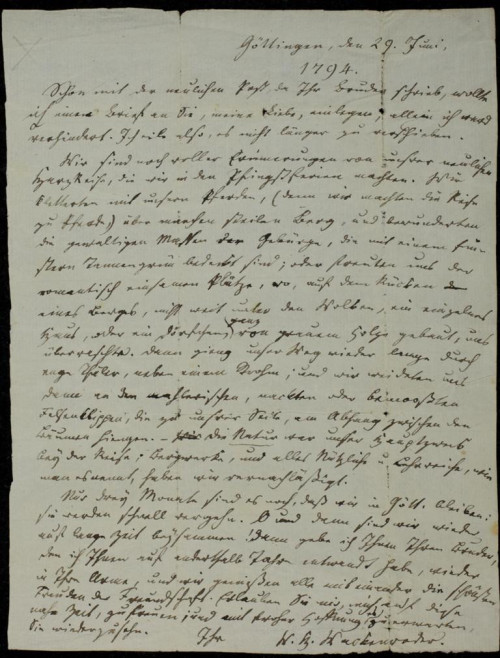 2F
2FWILHELM HEINRICH WACKENRODER (1773‒1798)
Letter to Sophie Tieck, Göttingen, June 29, 1794
-
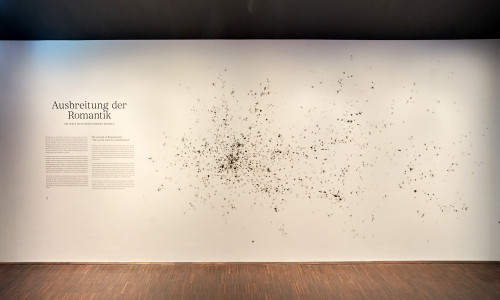 3F
3FIntroduction to the 3rd floor
The spread of Romanticism
“The world must be romanticized”
-
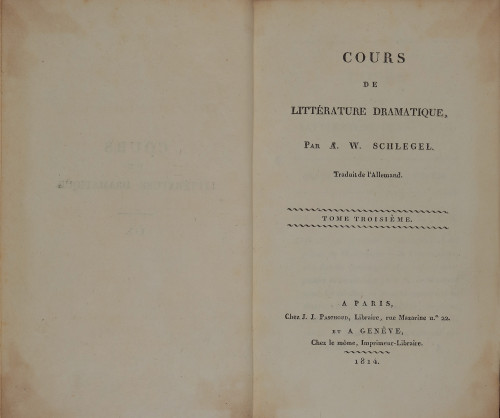 3F
3FAUGUST WILHELM SCHLEGEL
A Course of Lectures on Dramatic Art and Literature, by Augustus William Schlegel
Translated from the Original German by John Black. 2 Bände. London: Baldwin, Cradock and Joy; Edinburgh: Blackwood; Dublin: Cumming 1815.
-
Karoline von Günderrode
Letter to Clemens Brentano, Frankfurt a. M., May 19, 1802
Transkribierter Text
-
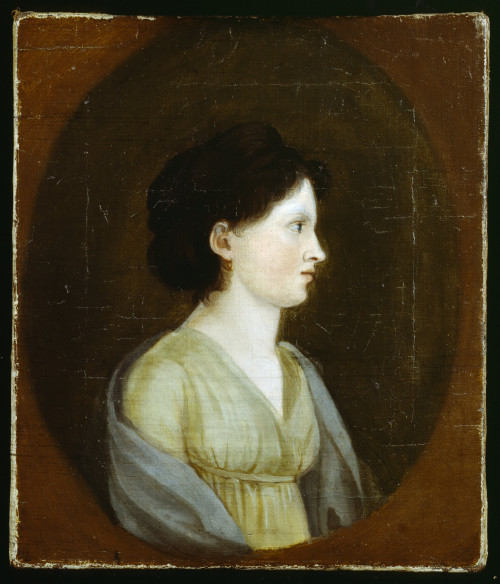
Why should anyone be different from how they are?
A guided tour through manuscripts by and about Karoline von Günderrode
-
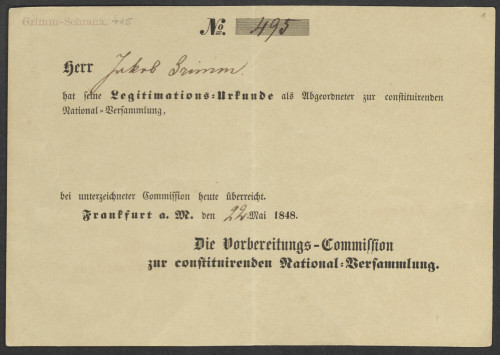
‘Deed of Legitimacy’ for Jacob Grimm
Display Case 1
-
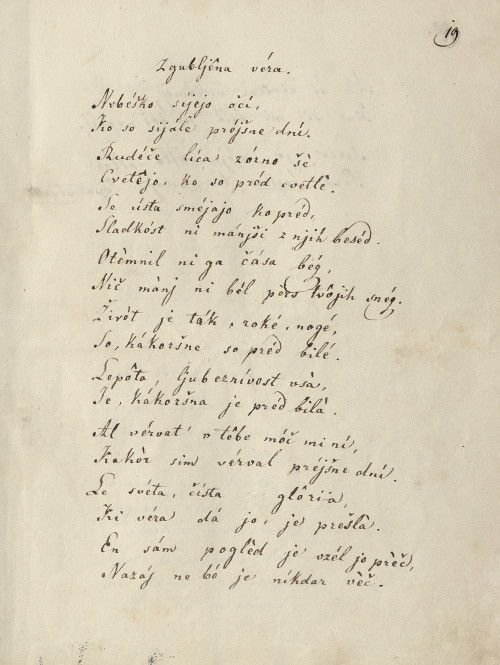
Lost Faith
Zgubljena vera
-
 3F
3FMessage to Europe
August Wilhelm Schlegel and Madame de Staël spread the Romantic idea (1813-1817)
-
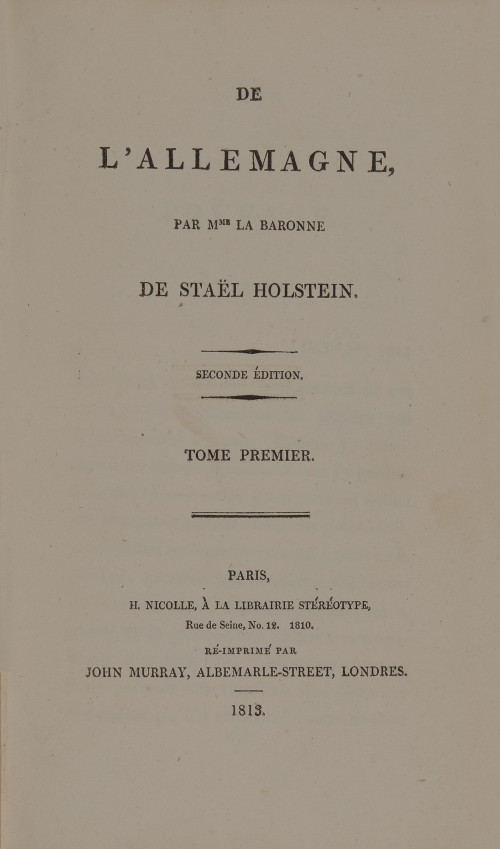 3F
3FGERMAINE DE STAËL (1766‒1817)
De l’Allemagne, par Mme la Baronne de Staël Holstein.
London: Murray 1813.
-
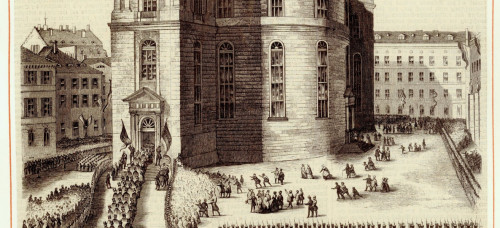
Romanticism and Parliamentarianism
Jacob Grimm and Ludwig Uhland in the Paulskirche in Frankfurt
-
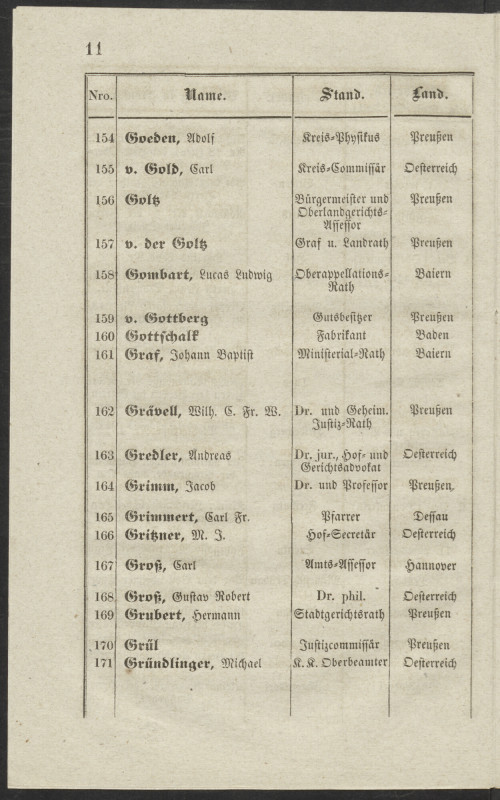
List of those deputies who registered to take part in the imperial assembly
Display Case 1
-
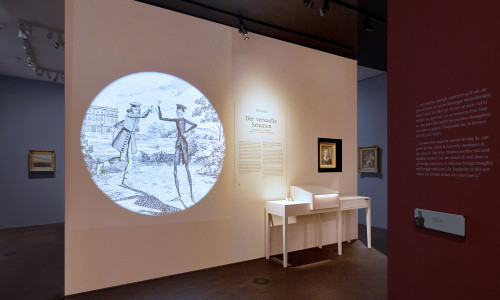 3F
3FThe man who sold his shadow
Adelbert von Chamisso tells a wondrous story (1814/24)
-
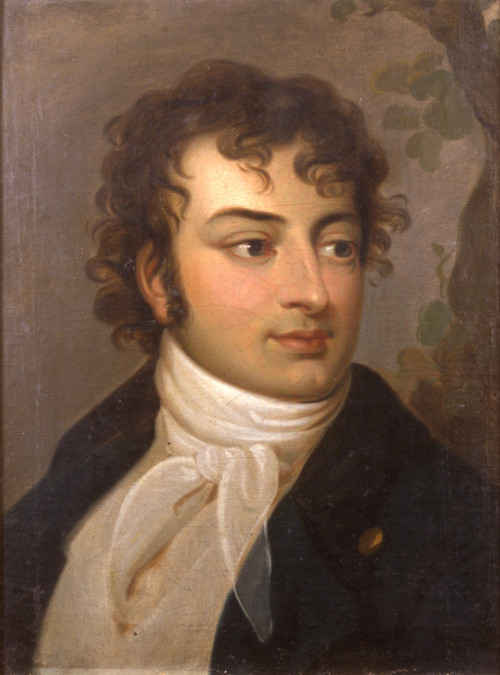 3F
3FUnbekannt
August Wilhelm Schlegel, um 1800/1802
-
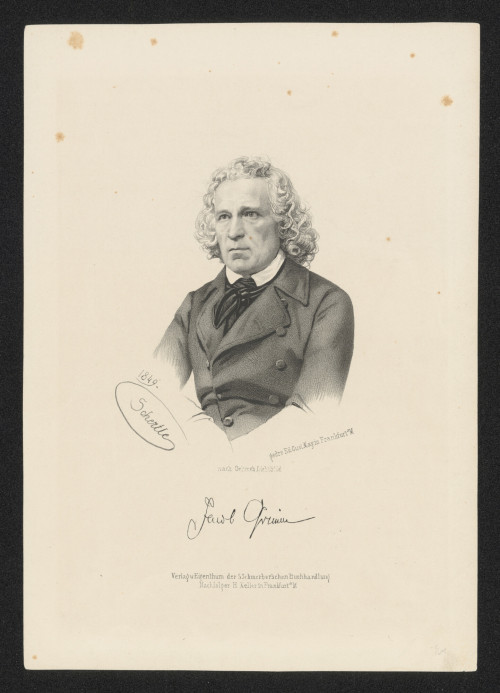
Introduction
Jacob Grimm
Display Case 1
-
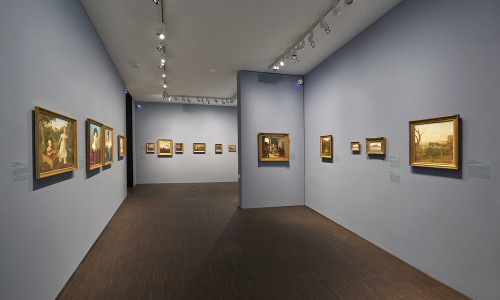 3F
3FRomantic Painting Cabinet
-
3F
AUGUST WILHELM SCHLEGEL
Über das Mittelalter. Eine Vorlesung (1803)
-
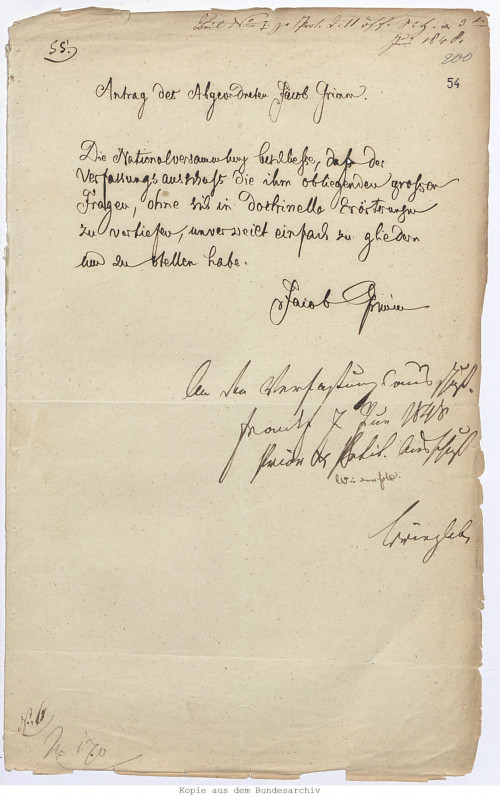
Jacob Grimm
Handwritten ‘Motion of Deputy Jacob Grimm’
Display Case 2
-
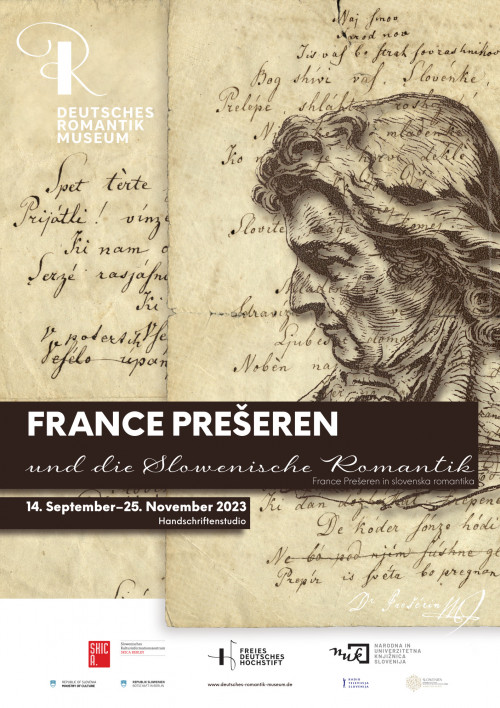
France Prešeren and Slovenian Romantik
-
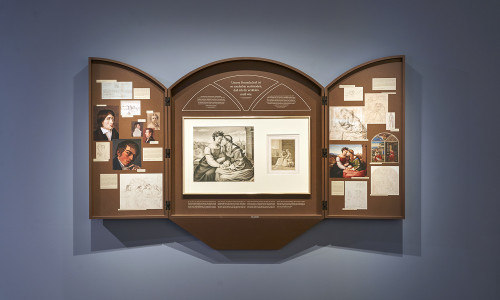 3F
3FLukasbrüder
-
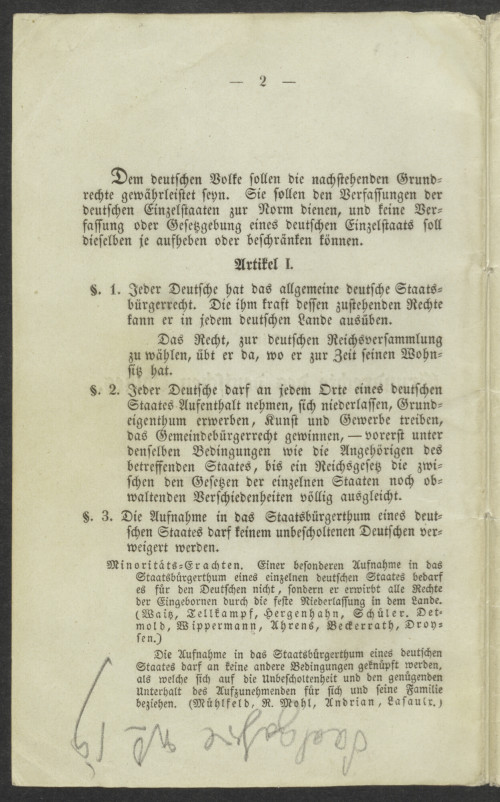
Jacob Grimm
Draft of “The Basic Rights of the German Nation
Display Case 2
-

Werther's world
The Werther year 1774
-
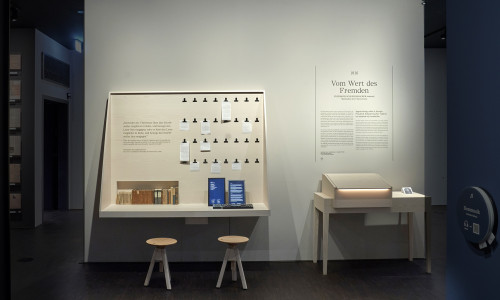 3F
3FFRIEDRICH SCHLEIERMACHER
Appreciating what is foreign
Friedrich Schleiermacher reflects on methods of translation (1816)
-
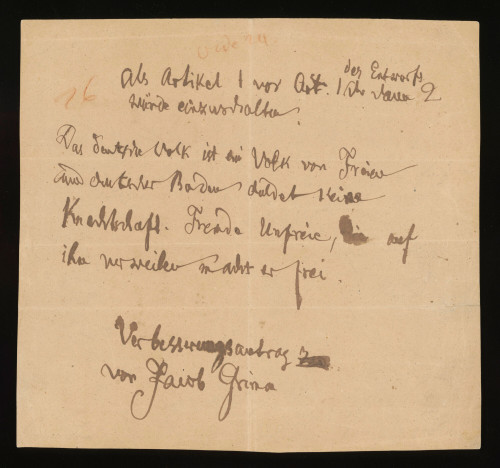
Jacob Grimm
Improvement of the “Basic Rights of the German Nation
Display Case 2
-
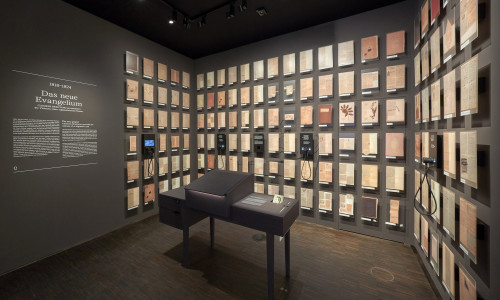 3F
3FCLEMENS BRENTANO
The new gospel
Clemens Brentano records the visions of a stigmatic nun (1818-1824)
-
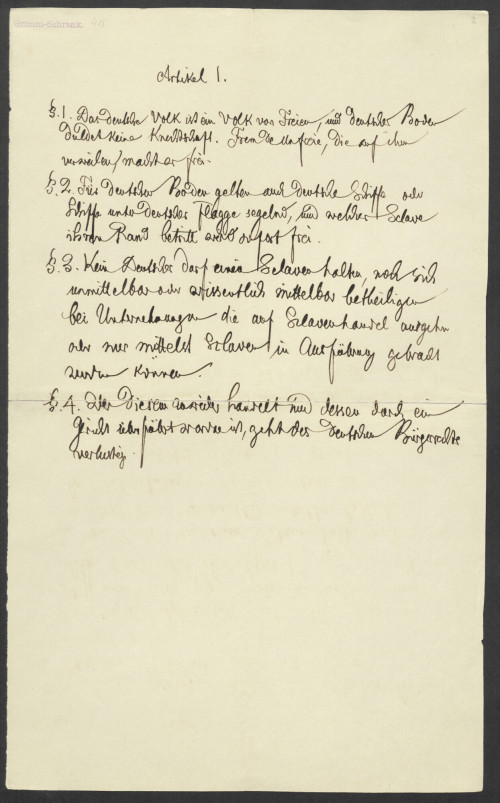
Jacob Grimm
Artikel 1
Display Case 2
-
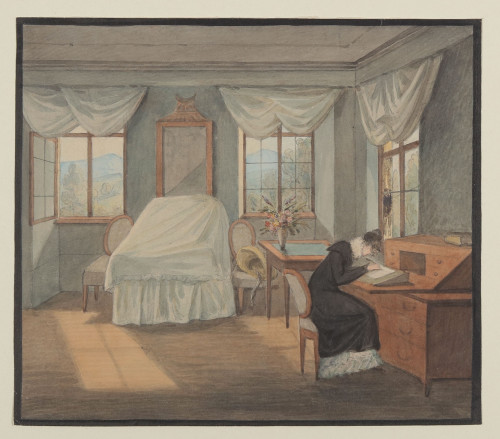
Close communication
-
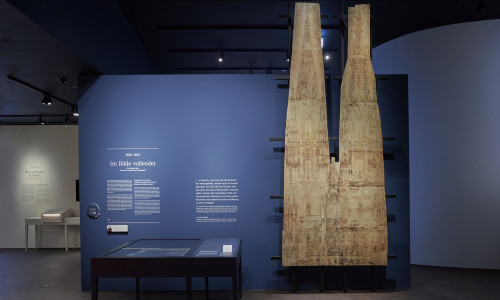 3F
3FCompleted in a picture
Cologne Cathedral becomes a Romantic building project (1823-1832)
-
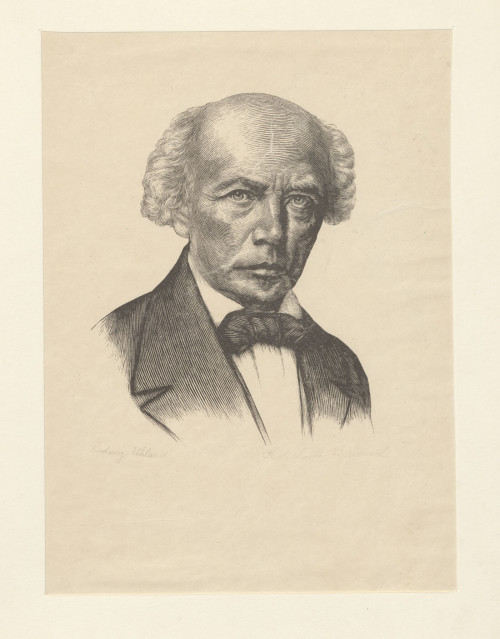
Introduction
Ludwig Uhland
Display Case 3
-
 3F
3FE.T.A. HOFFMANN
Looking through the mind microscope
E.T.A. Hoffmann’s Frankfurt fairy tale Master Flea (1822)
-
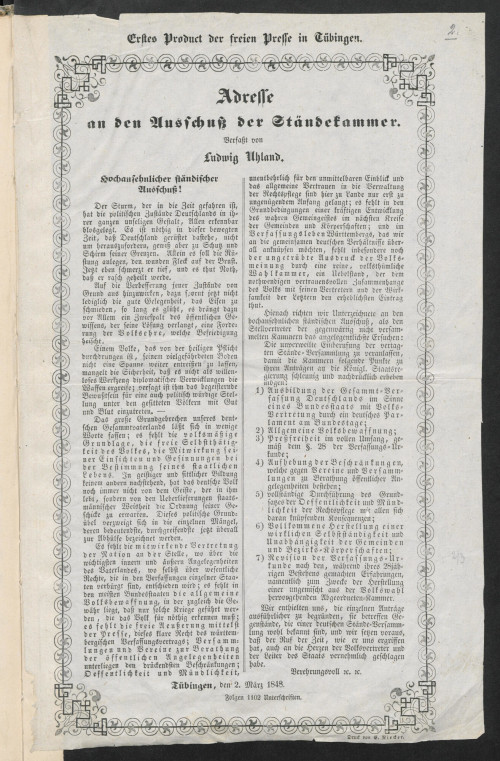
Ludwig Uhland
Address to the Committee of the Chambers of the Estates
Display Case 3
-
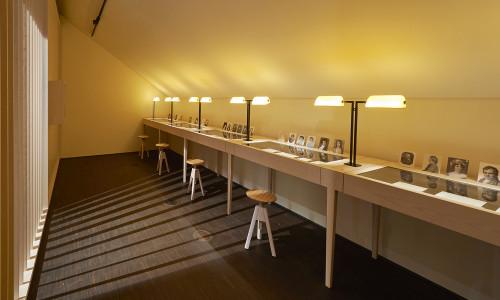 3F
3FManuscript Studio
-
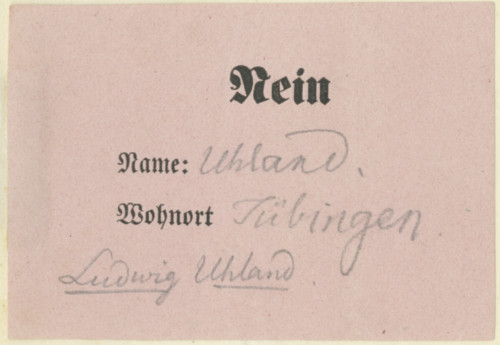
Ludwig Uhland
Ballot paper for the Frankfurt National Assembly
Display Case 3
-
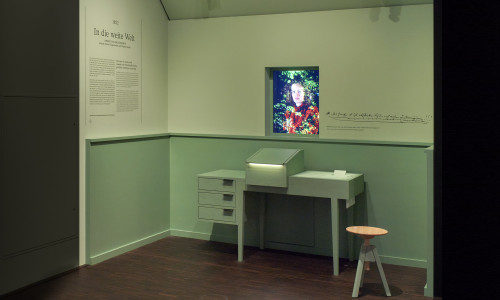 3F
3FJOSEPH VON EICHENDORFF
Out into the wide world
Joseph von Eichendorff sends a good-for-nothing on a journey (1822)
-
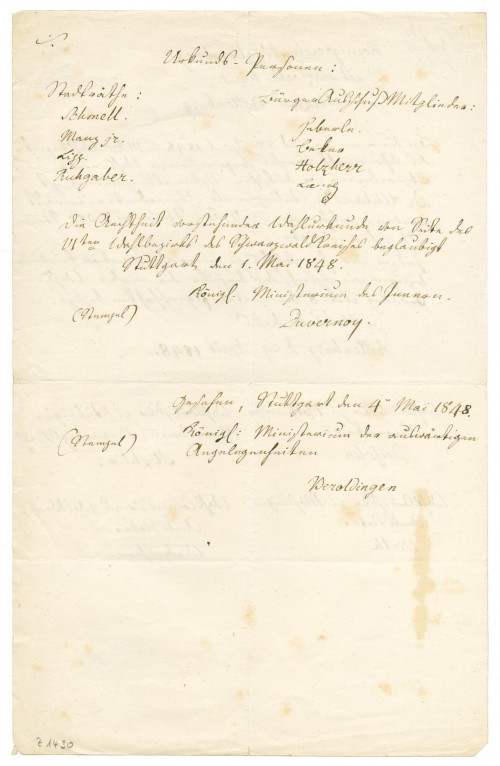
Copy of the Deed of Legitimacy on the election of Deputy Ludwig Uhland
Display Case 4
-
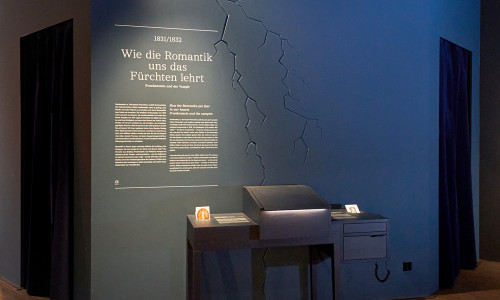 3F
3FMARY SHELLEY
How the Romantics put fear in our hearts
Frankenstein and the vampire (1831/32)
-
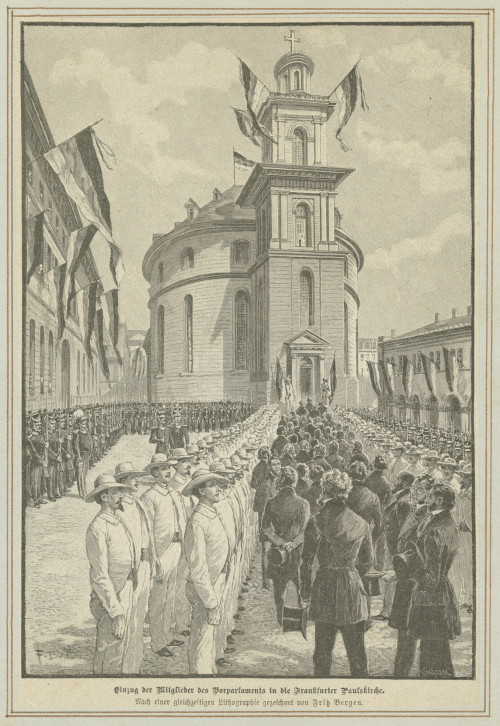
An evening of entertainment by the Frankfurter Liederkranz on the Mainlust
Display Case 4
-
 3F
3FRAHEL VARNHAGEN
Equality in action
Memories of Rahel Varnhagen (1834/35)
-
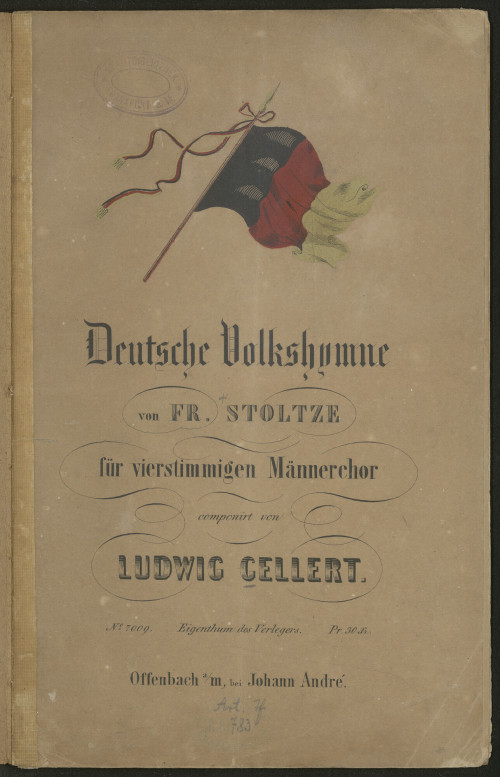
Friedrich Stoltze
German folk anthem
Vitrine 4
-
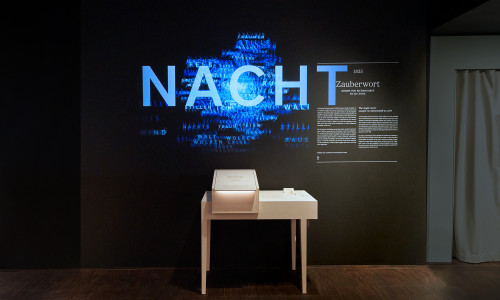 3F
3FJOSEPH VON EICHENDORFF
The magic word
Joseph von Eichendorff at work (1835)
-
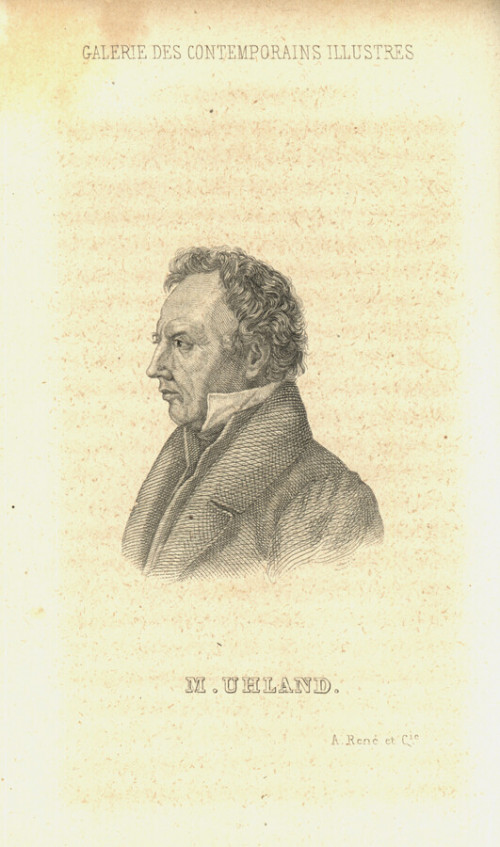
Ludwig Uhland
Motion ‘for the periodic election by the parliament of an imperial head of state’
Display Case 5
-
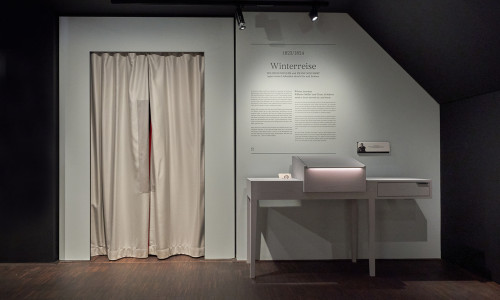 3F
3FWILHELM MÜLLER
Winter journey
Wilhelm Müller and Franz Schubert send a lover across ice and snow (1823/24)
-
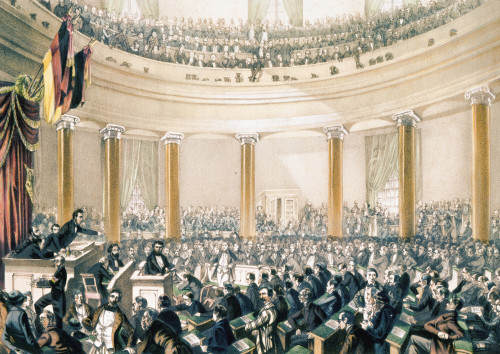
Communiqué of the results of the vote on Ludwig Uhland’s motion
Display Case 5
-
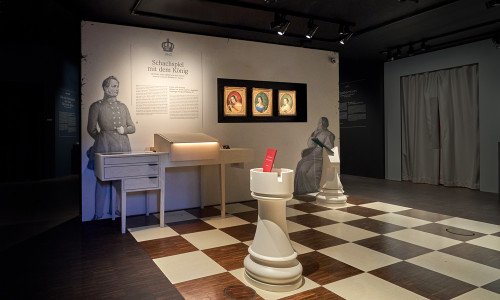 3F
3FBETTINE VON ARNIM
Chess with the king
Bettine von Arnim and her daughters challenge Friedrich Wilhelm IV (1840/44)
-

Ludwig Uhland
Proposed Amendment to §45 of the ‘Draft of the Basic Rights of the German Nation’
Display Case 5
-
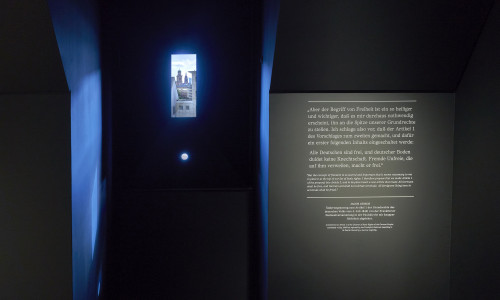 3F
3FWindow to St. Paul’s Church
-
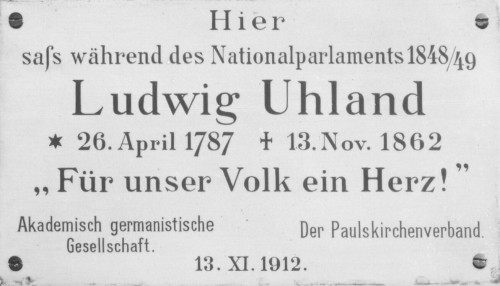
Photograph of a memorial plaque (detail)
Center Display Case
-
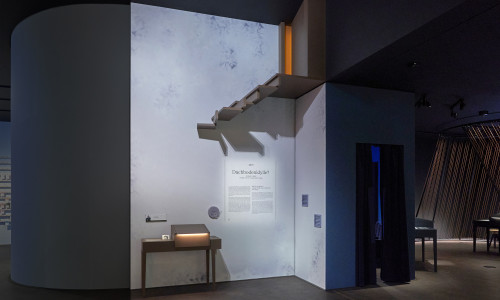 3F
3FLUDWIG TIECK
Idyll in the garret?
Ludwig Tieck tells a Romantic love story (1837)
-
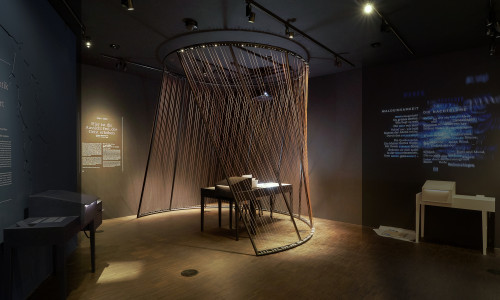 3F
3FROBERT SCHUMANN
Here the view is free, the spirit lifted
Robert Schumann sets Goethe’s Faust to music
-
 3F
3FEpilog
Romanticism – no end in sight? (1859)
-
 3F
3FElliptical stairwell with prism installation
-
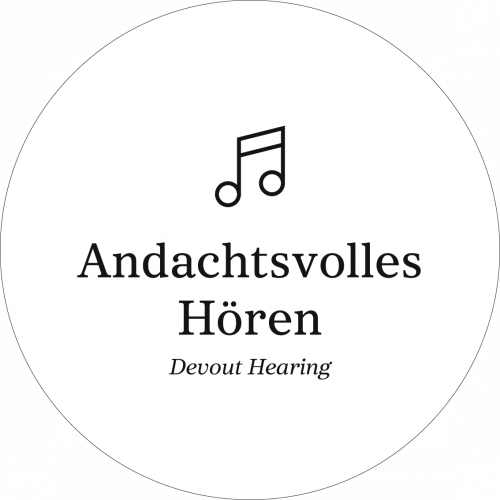
2F
GREGORIO ALLEGRI
Miserere, after 1630
Le Poème Harmonique. Leitung: Vincent Dumestre. Alpha 2019.
-
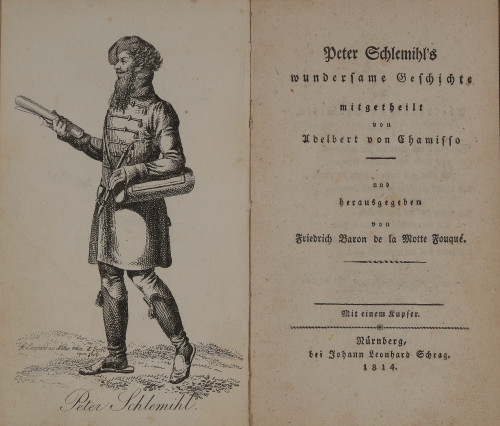 3F
3FADELBERT VON CHAMISSO
Peter Schlemihl’s wundersame Geschichte mitgetheilt von Adelbert von Chamisso und herausgegeben von Friedrich Baron de la Motte Fouqué
Nürnberg: Schrag 1814.
-
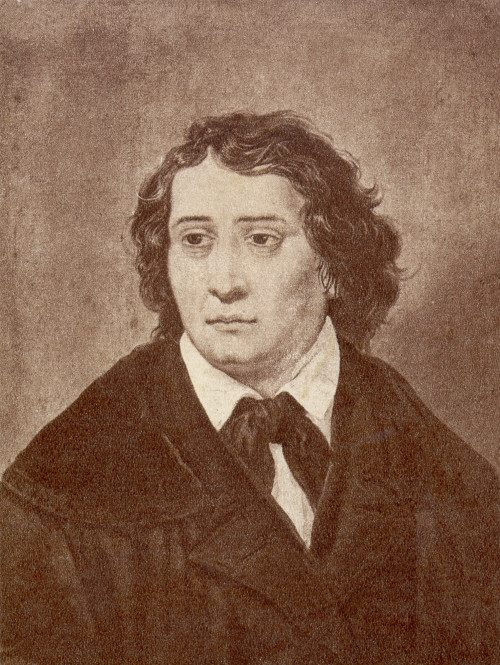
Sonnets of Misfortune (The Wanderer Arrives in the Desert of Africa)
Sonetje nesreče
-
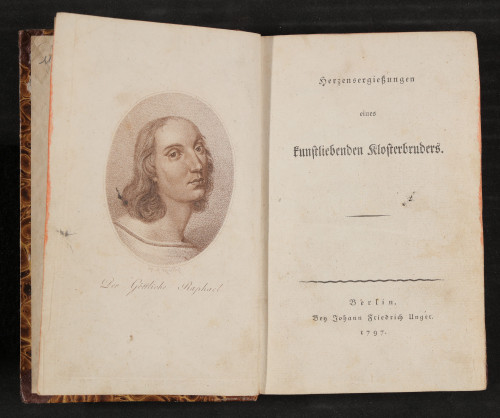 2F
2FWILHELM HEINRICH WACKENRODER, LUDWIG TIECK
Herzensergießungen eines kunstliebenden Klosterbruders
Berlin: Unger 1797.
-
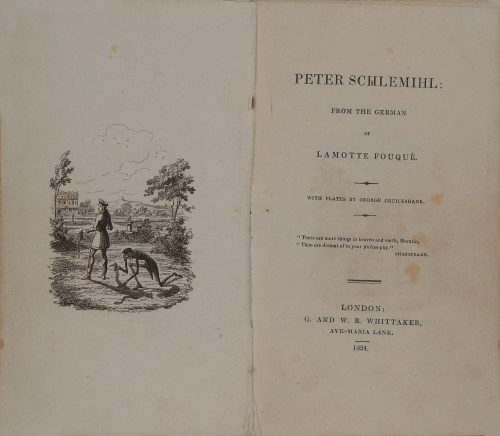 3F
3FADELBERT VON CHAMISSO
Peter Schlemihl: From the German of Lamotte Fouqué. With Plates by George Cruickshank
London: Whittaker 1824.
-

Sixth ghasele
Gazele
-
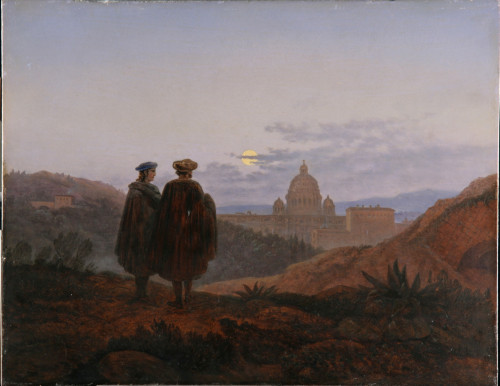 2F
2FCARL GUSTAV CARUS
Erinnerung an Rom II, 1839
-
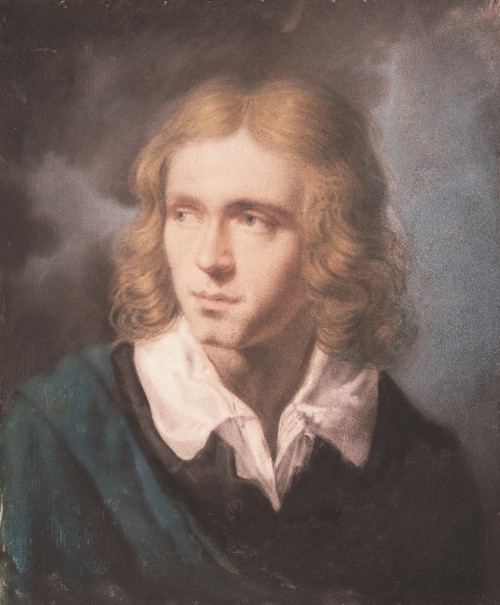 3F
3FUNBEKANNTE/R KÜNSTLER/IN
Adelbert von Chamisso, ca. 1810
-
3F
LUDWIG YORK CHORIS (1795‒1828)
Chamisso an Bord der Rurik in der Kajüte, 1815; Brigg Rurik mit Kriegsflagge und Kanonen, 1815
-
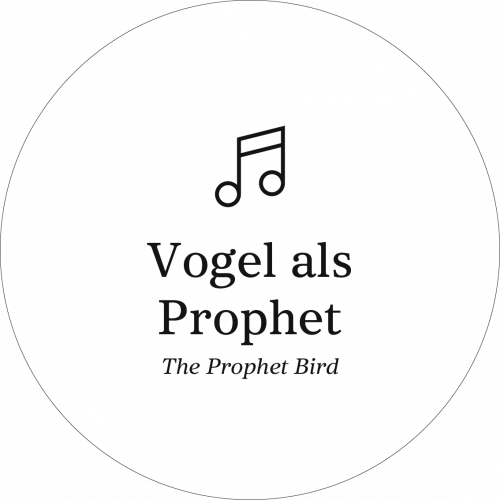
2F
ROBERT SCHUMANN
Vogel als Prophet, 1849
-
 3F
3FCarl Gustav Carus
DEUTSCHER MONDSCHEIN
1833
-

Who was France Prešeren?
Introduction
-

A Toast
Zdravljica (National anthem of Slovenia)
-
 2F
2FLUDWIG TIECK
Volksmährchen herausgegeben von Peter Leberecht
Band 1 (von 3). Berlin: Carl August Nicolai 1797. S. 191–242: Der blonde Eckbert.
-
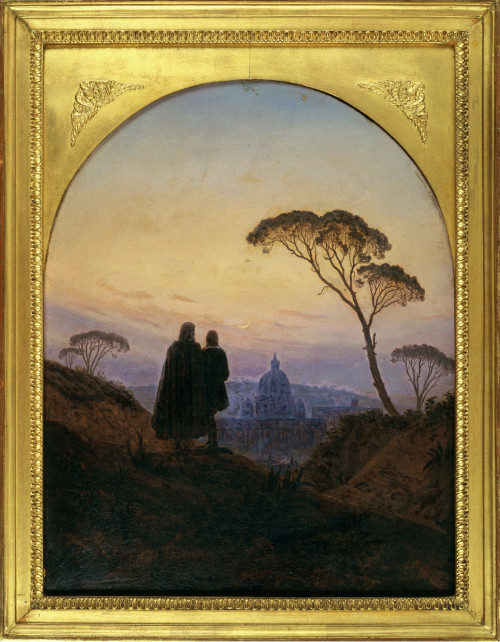 3F
3FCarl Gustav Carus
ERINNERUNG AN ROM I
1831
-
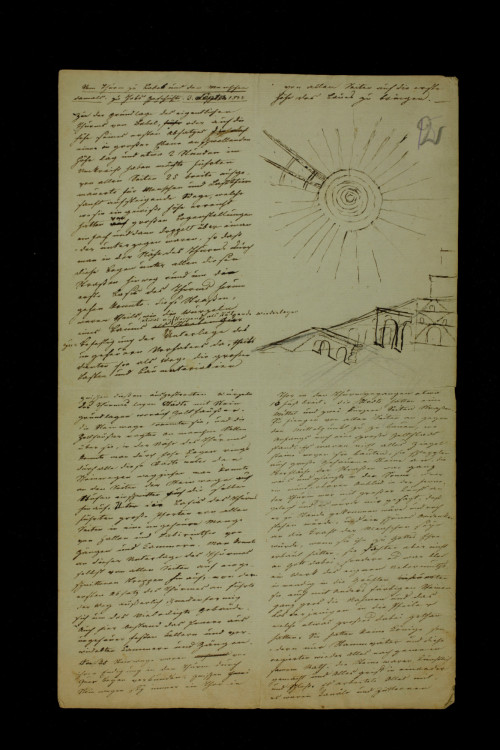
Clemens Brentano
Der Turm zu Babel
Audio station 1, on the right
-

A year has passed since the happy time
Showcase 1
-
 2F
2FJOHANN KARL AUGUST MUSÄUS
Volksmährchen der Deutschen
Gotha: Ettinger 1787/88.
-
 3F
3FCarl Gustav Carus
ITALIENISCHER MONDSCHEIN
1833
-
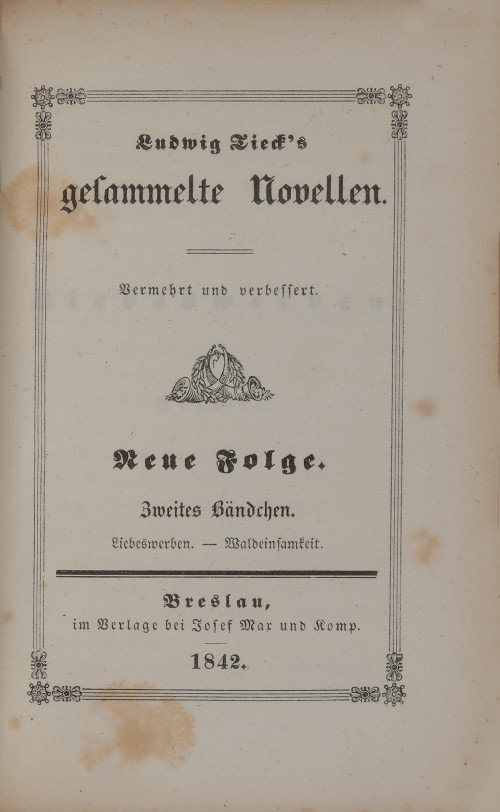 2F
2FLUDWIG TIECK
Ludwig Tieck’s gesammelte Novellen
Band 12 (= Neue Folge, Band 2): Liebeswerben ‒ Waldeinsamkeit. Breslau: Max 1842.
-
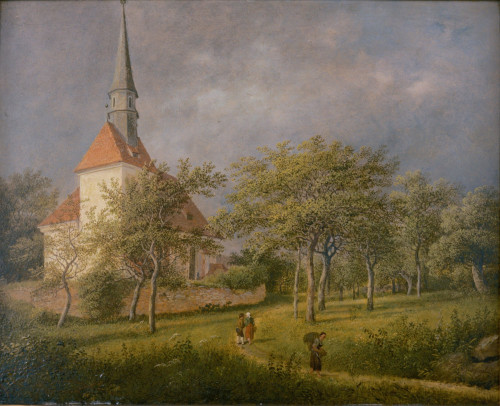 3F
3FJohann Christian Klengel
DORFKIRCHE VON PLAUEN
-

Encouragement for Poets
Showcase 3
-
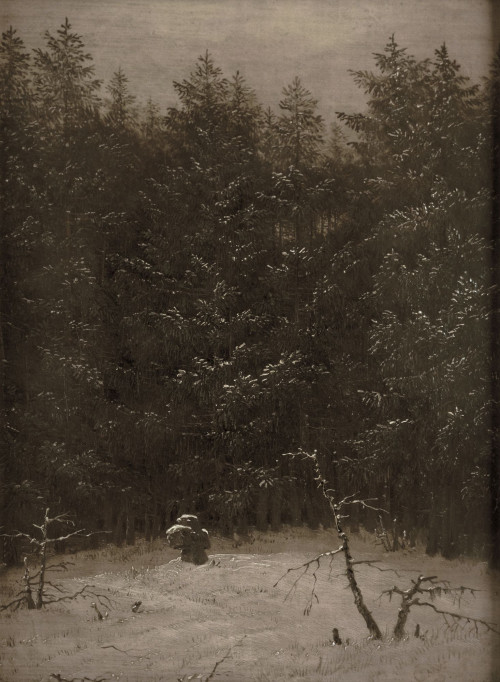 3F
3FCarl Gustav Carus
VERSCHNEITER WALD MIT STEINKREUZ
1823
-
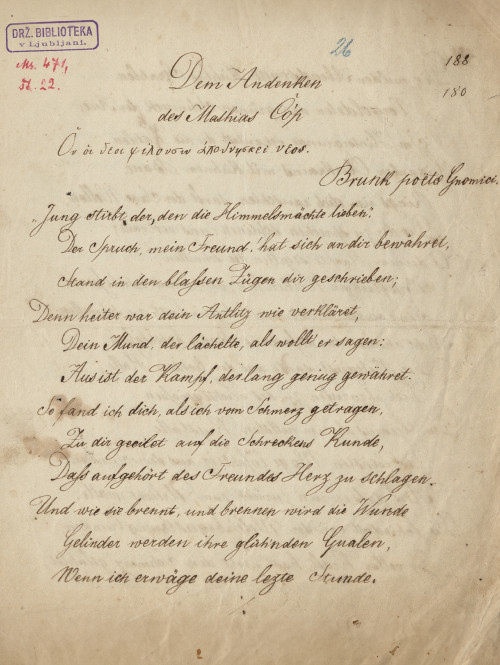
You friends, Raise your Glasses
Showcase 4
-
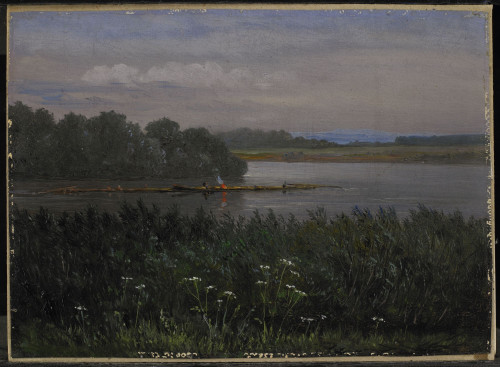 3F
3FCarl Gustav Carus
ELBINSEL BEI PILLNITZ
Um 1832/34
-
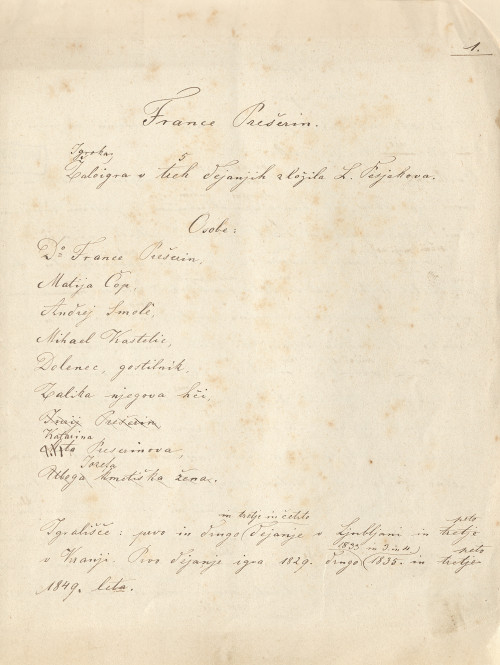
To a young poetess
Showcase 5
-
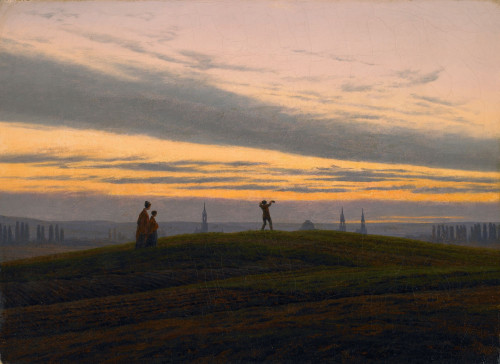 3F
3FCaspar David Friedrich
DER ABENDSTERN
1830
-

Prešerens Gedichte
Translations
-
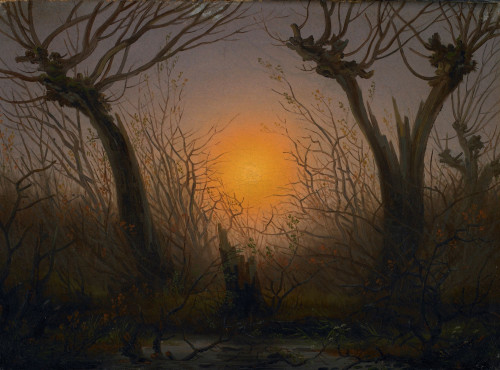 3F
3FCaspar David Friedrich
WEIDENGEBÜSCH BEI TIEFSTEHENDER SONNE
Um 1832/35
-
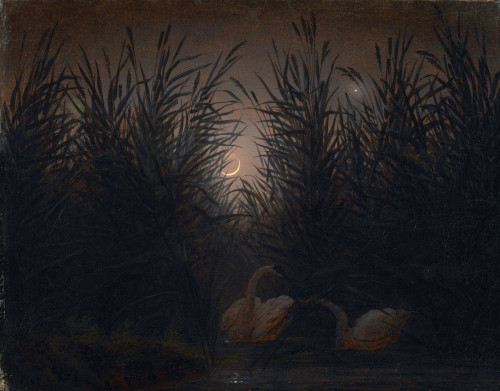 3F
3FCaspar David Friedrich
SCHWÄNE IM SCHILF
Um 1819/20
-
 3F
3FCarl Christian Vogel von Vogelstein
DAVID D’ANGERS MODELLIERT DIE BÜSTE LUDWIG TIECKS
1836. Dauerleihgabe der Bundesrepublik Deutschland.
-
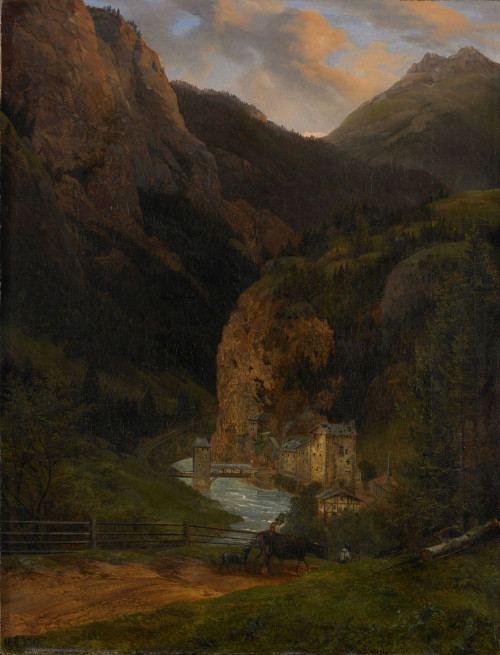 3F
3FErnst Ferdinand Oehme
TAL VON FINSTERMÜNZ IN TIROL
1830
-
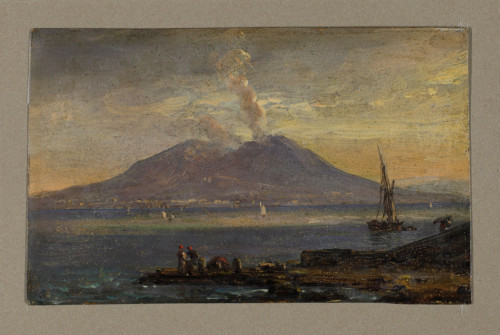 3F
3FJohan Christian Clausen Dahl
DER VESUV, GESEHEN VOM POSILLIPO
1847
-
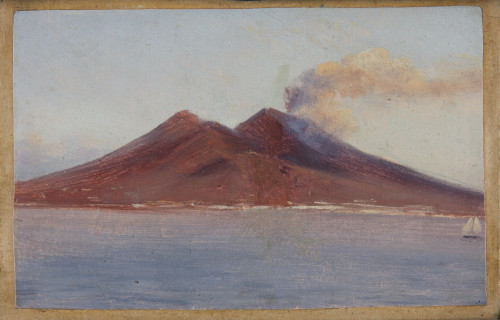 3F
3FCarl Blechen
DER VESUV
1829. Dauerleihgabe der Bundesrepublik Deutschland.
-
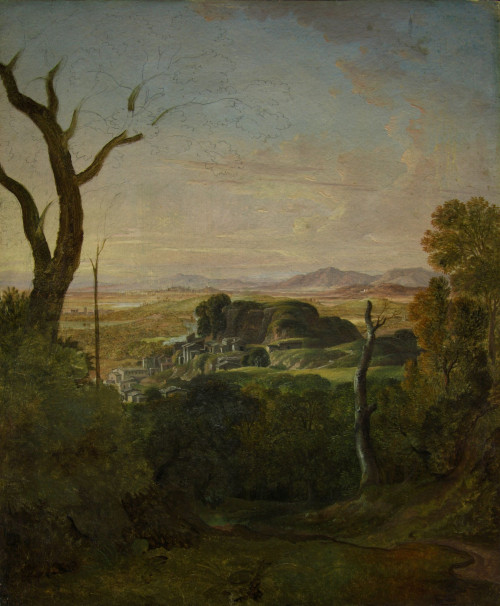 3F
3FCarl Ludwig Kaaz
RÖMISCHE LANDSCHAFT BEI TIVOLI
Um 1802/04
-
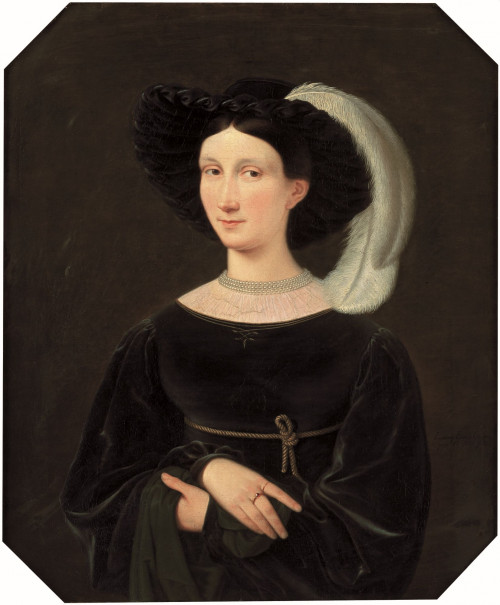 3F
3FLudwig Emil Grimm
MELINE VON GUAITA GEB. BRENTANO
1820. Dauerleihgabe aus Privatbesitz.
-
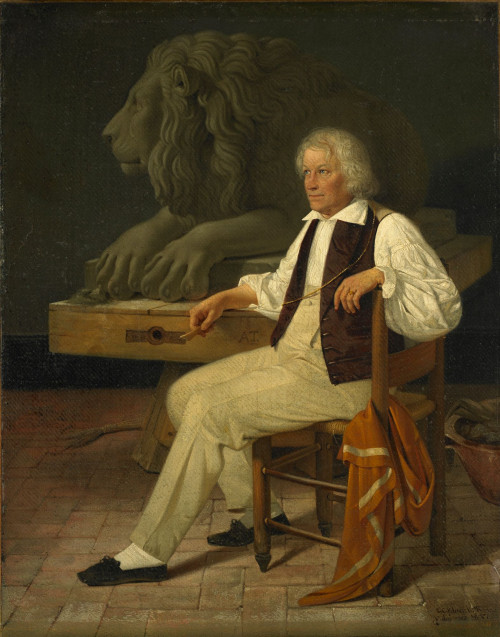 3F
3FDetlev Conrad Blunck
BERTEL THORVALDSEN IN SEINEM RÖMISCHEN ATELIER
1837
-
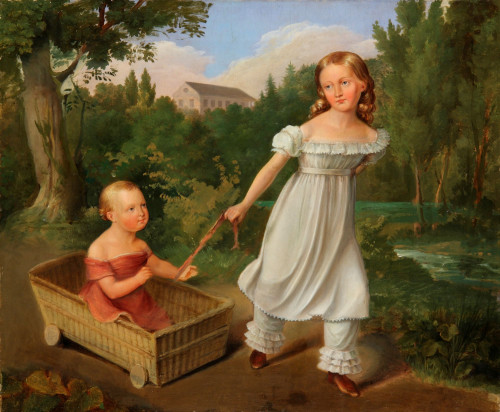 3F
3FFerdinand Jagemann
DIE HEYGENDORFFSCHEN KINDER
1812
-
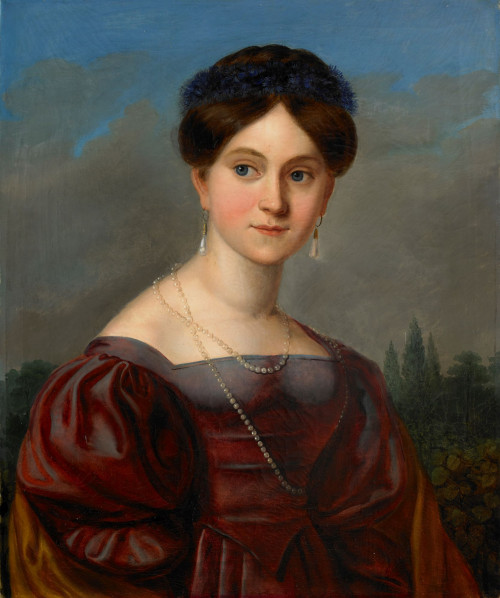 3F
3FLouise Seidler
JULIE ZSCHALER
1832
-
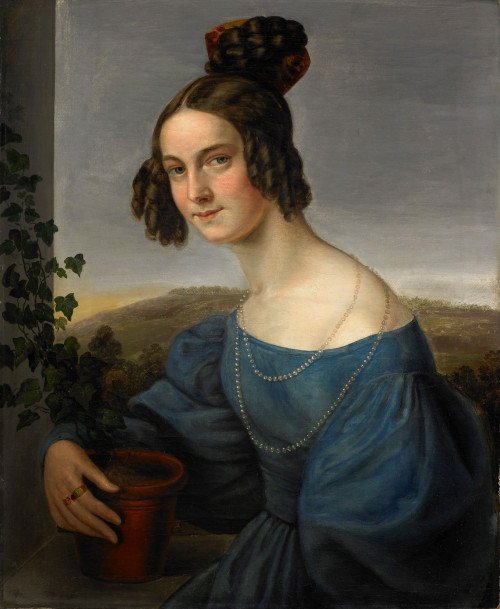 3F
3FLouise Seidler
OTTILIE ARNOLDI
1832
-
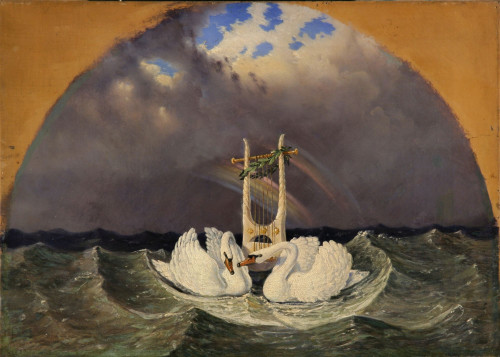 3F
3FCarl Gustav Carus
ALLEGORIE AUF GOETHES TOD
1832
-
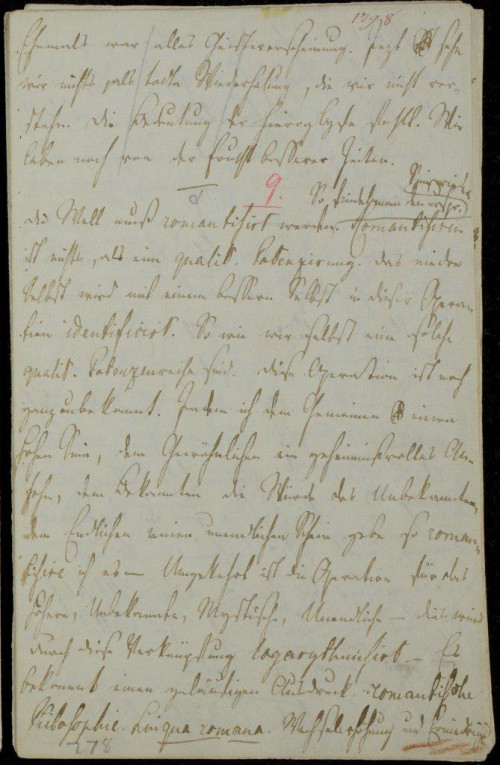 2F
2FFRIEDRICH VON HARDENBERG (NOVALIS)
Die Welt muß romantisirt werden, Spring 1798
-
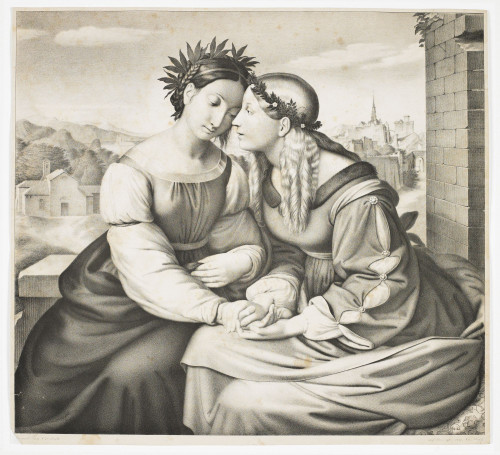 3F
3FNIKOLAUS HOFF nach JOHANN FRIEDRICH OVERBECK
Italia und Germania, 1830
-

To the memory of Matthias Čop
-
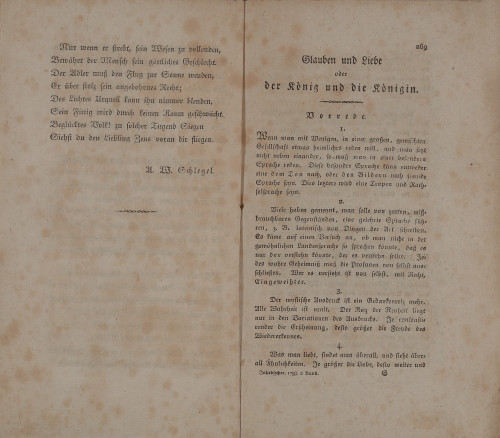 2F
2FFRIEDRICH VON HARDENBERG (NOVALIS)
Glauben und Liebe
In: Jahrbücher der preußischen Monarchie. Herausgegeben von Friedrich Eberhard Rambach. Berlin: Unger Juni / Juli 1798. Teil 1: Blumen, Juni 1798, S. 184–185. Teil 2: Glauben und Liebe oder der König und die Königin, Juli 1798, S. 269–286.
-
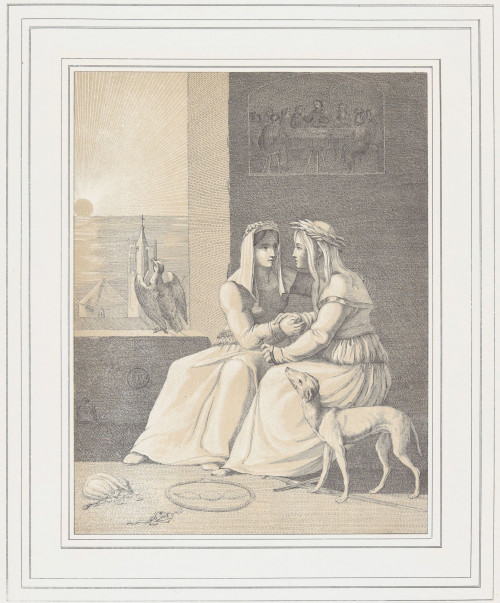 3F
3FLOUIS KRAMP nach FRANZ PFORR
Die Freundschaft, 1832
-
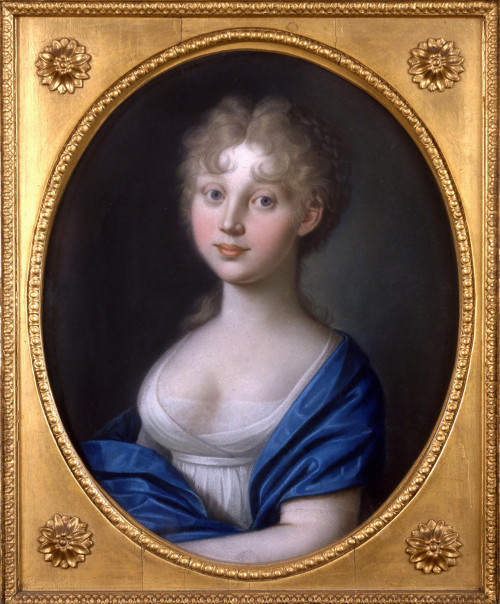 2F
2FNIKOLAUS LAUER
Luise Queen of Prussia, 1797/98; Friedrich Wilhelm III. King of Prussia, 1797/98;
-
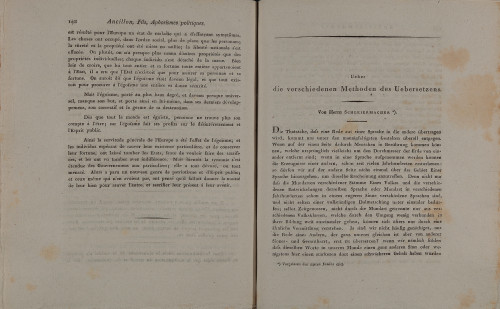 3F
3FFRIEDRICH SCHLEIERMACHER
Über die verschiedenen Methoden des Übersetzens. Von Herrn Schleiermacher
Berlin: Realschul-Buchhandlung 1816, S. 143‒172.
-
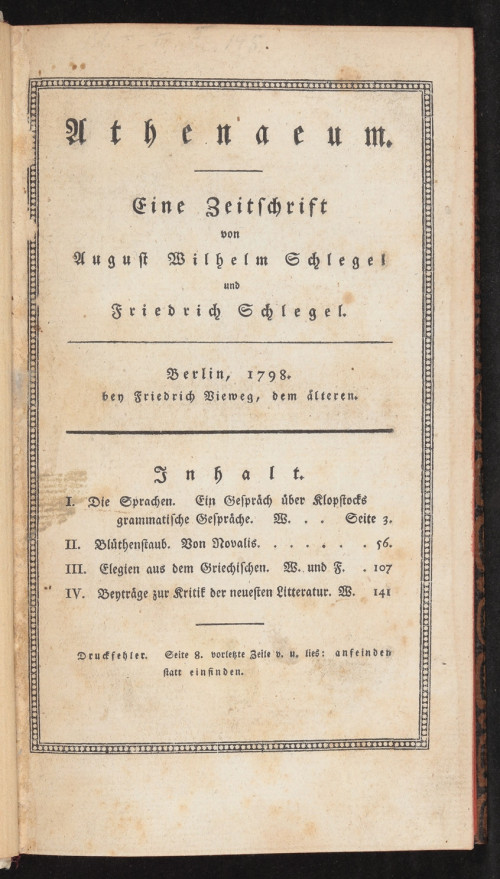 2F
2FAUGUST WILHELM SCHLEGEL, FRIEDRICH SCHLEGEL
Athenaeum. Eine Zeitschrift von August Wilhelm Schlegel und Friedrich Schlegel
6 Hefte in 3 Bänden. Berlin: Vieweg 1798; Berlin: Frölich 1799–1800.
-
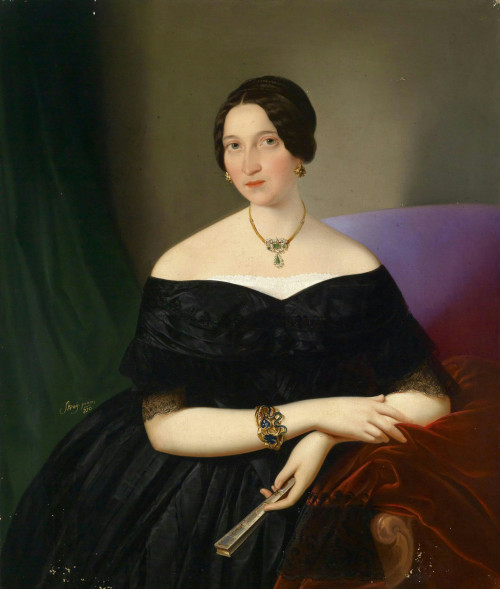
Diary of Luiza Pesjak
-
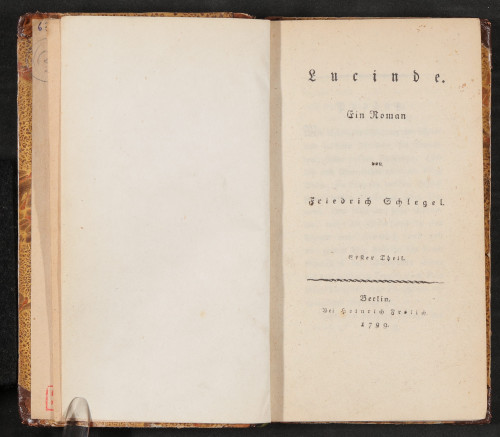 2F
2FFRIEDRICH SCHLEGEL
Lucinde. Ein Roman von Friedrich Schlegel
Berlin: Frölich 1799.
-
2F
AUGUST WILHELM, FRIEDRICH UND CAROLINE SCHLEGEL
Letter to Friedrich von Hardenberg (Novalis), Dresden, July 1, 1798
-
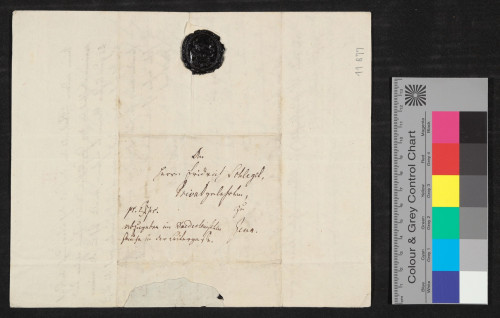 2F
2FFRIEDRICH VON HARDENBERG (NOVALIS)
Letter to Friedrich Schlegel, Tennstedt, May 3, 1797
-
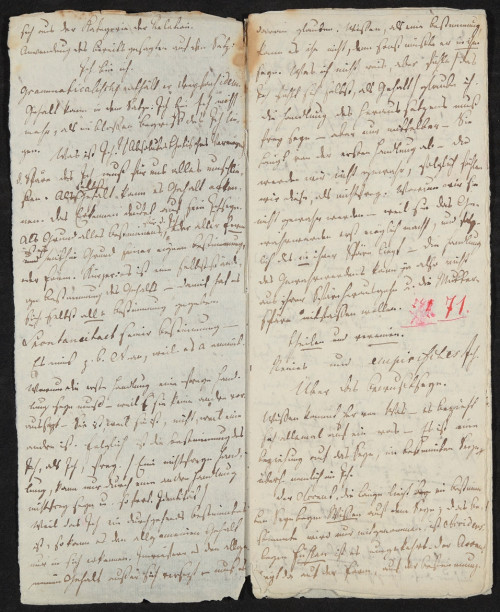 2F
2FFRIEDRICH VON HARDENBERG (NOVALIS)
Bemerkungen, Autumn 1795
-
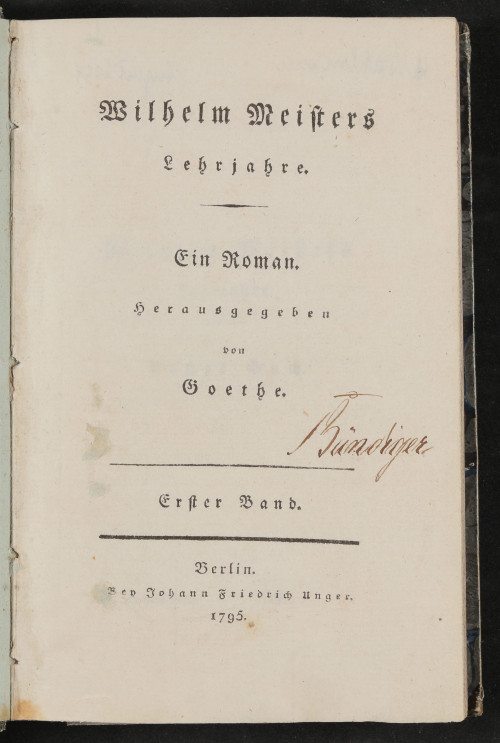 2F
2FJOHANN WOLFGANG VON GOETHE
Wilhelm Meisters Lehrjahre. Ein Roman. Herausgegeben von Goethe
Band 1 (von 4). Berlin: Unger 1795.
-
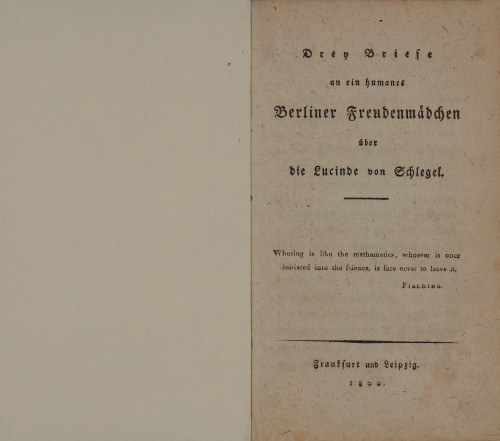 2F
2FANONYM
Drey Briefe an ein humanes Berliner Freudenmädchen über die Lucinde von Schlegel
Frankfurt a. M. und Leipzig: Nauck 1800.
-
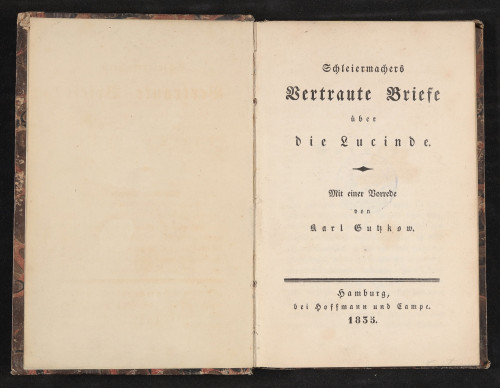 2F
2FFRIEDRICH SCHLEIERMACHER
Schleiermachers Vertraute Briefe über die Lucinde. Mit einer Vorrede von Karl Gutzkow
Hamburg: Hoffmann und Campe 1835.
-
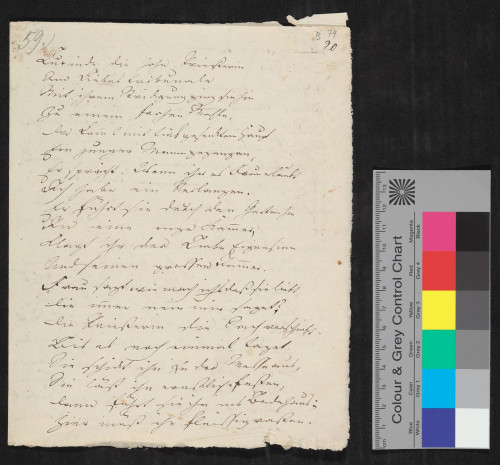 2F
2FACHIM VON ARNIM
Lucinde die hohe Priesterin, 1802
-
3F
CLEMENS BRENTANO
Dülmener Tagebücher (1818/19 und um 1825)
-
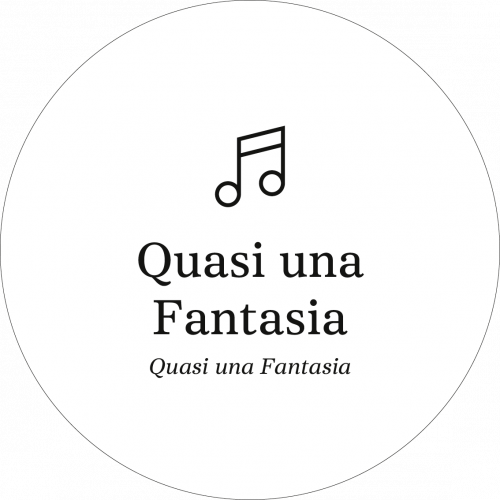
2F
LUDWIG VAN BEETHOVEN
Klaviersonate Nr. 14 cis-Moll, 1801
1. Satz: Adagio sostenuto. Sylvia Ackermann (Hammerflügel von Melchior Guante, Münster 1795). Deutsches Romantik-Museum 2021.
-
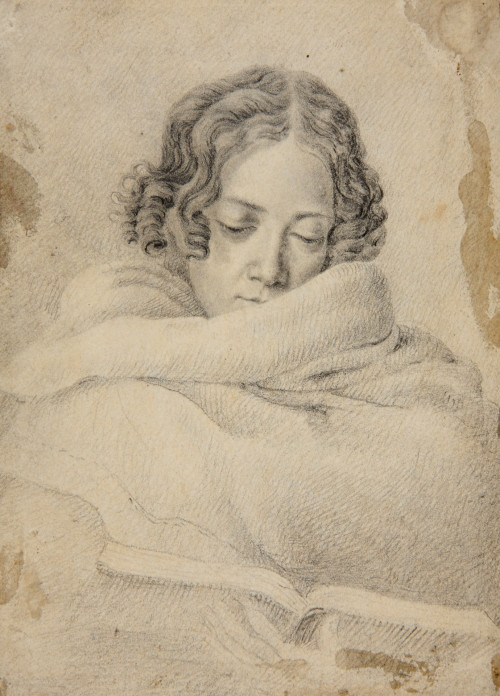
1st chapter: Bettina Brentano
-
 3F
3FCLEMENS BRENTANO
Das bittere Leiden unsers Herrn Jesu Christi. Nach den Betrachtungen der gottseligen Anna Katharina Emmerich, Augustinerin des Klosters Agnetenberg zu Dülmen († 9. Febr. 1824.) nebst dem Lebensumriß dieser Begnadigten
1833
-
2F
FRIEDRICH VON HARDENBERG (NOVALIS)
Heinrich von Afterdingen. Ein Roman von Novalis. Erster Theil. Die Erwartung (Anfang 1800)
-
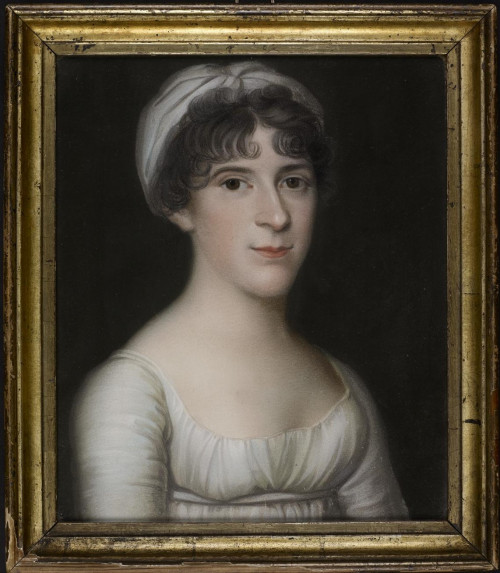
2nd chapter: Rahel Levin Varnhagen’s Intimate Writing
-
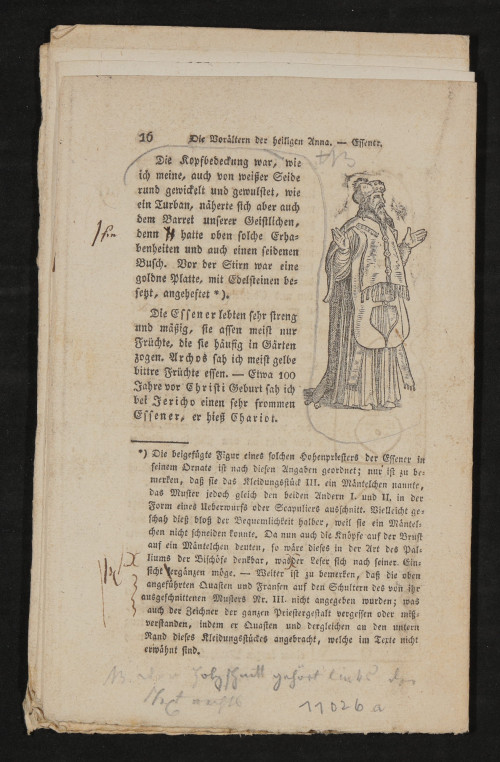 3F
3FCLEMENS BRENTANO
Leben der heil. Jungfrau Maria. First proof, 1840
-
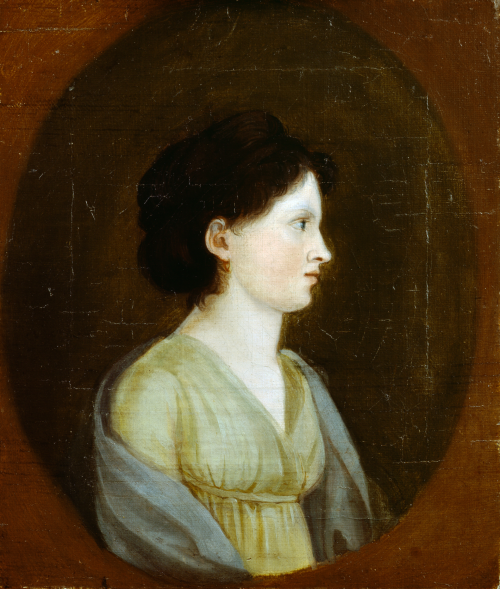
3rd chapter: Karoline von Günderrode
-
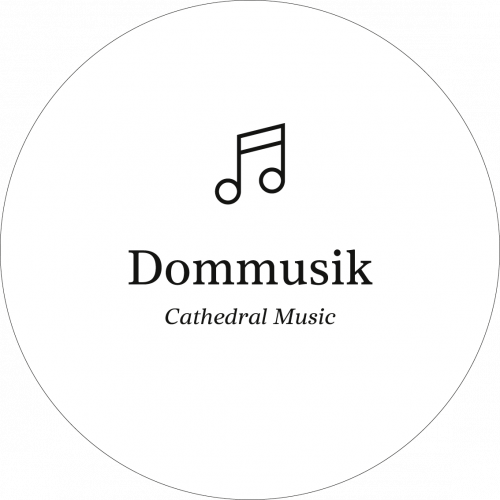
3F
FELIX MENDELSSOHN BARTHOLDY
Verleih uns Frieden gnädiglich, 1831
Stuttgart Chamber Choir, Director: Frieder Bernius. Carus 1999
-
 2F
2FCLEMENS BRENTANO
Letter to Karoline von Günderrode, Marburg, mid-May 1802
-
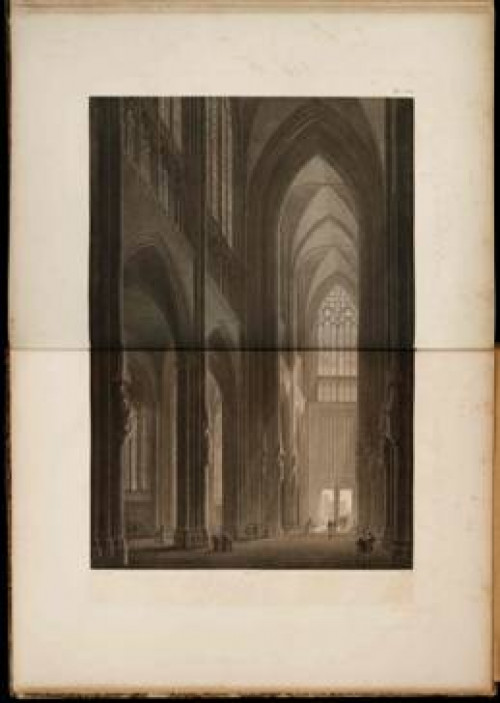 3F
3FSULPIZ BOISSERÉE
Histoire et description de la cathédrale de Cologne
Stuttgart: Cotta 1821
-
2F
KAROLINE VON GÜNDERRODE
Letter to Clemens Brentano, Frankfurt a. M., May 19, 1802
-
 3F
3FMICHAEL VON SAVOYEN
Plan of Cologne Cathedral’s facade (Riss F)
© Hohe Domkirche Köln, Dombauhütte. Foto: Matz und Schenk.
-
 2F
2FCLEMENS BRENTANO
Letter to Johanna Kraus, Koblenz, probably July 1, 1802
-
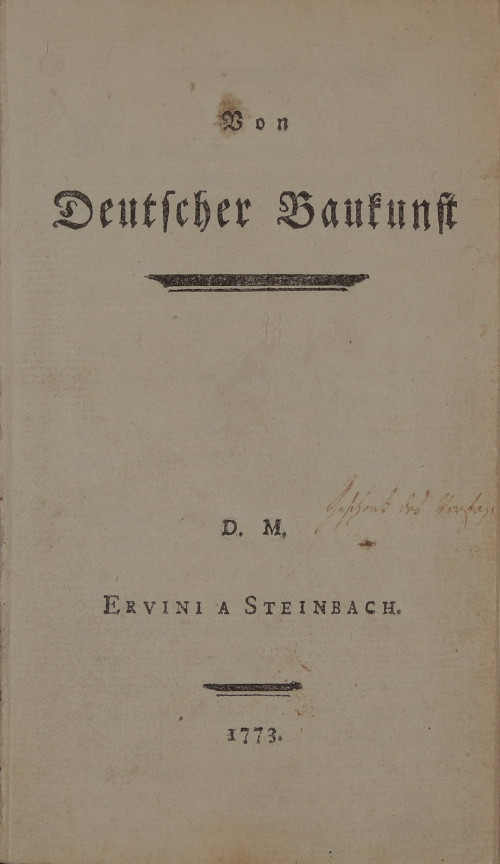 3F
3FJOHANN WOLFGANG VON GOETHE
Von deutscher Baukunst. D(is) M(anibus) Ervini a Steinbach
Frankfurt a.M.: 1773
-
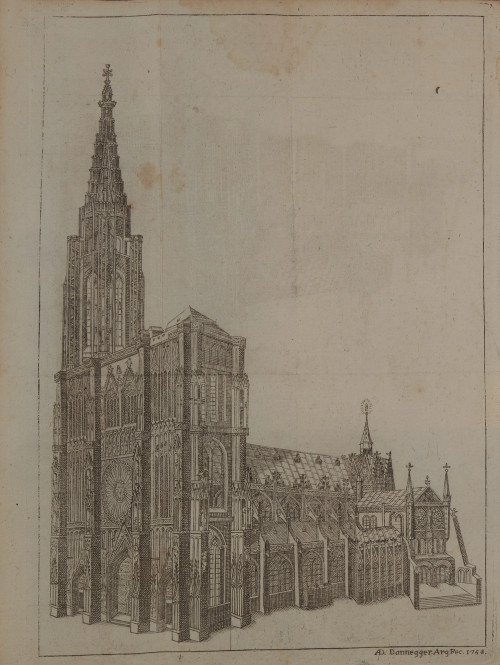 3F
3FGEORG HEINRICH BEHR
Straßburger Münster- und Thurn-Büchlein; oder: Kurtzer Begrif Der merckwürdigsten Sachen, so im Münster und dasigem Thurn zu finden
Straßburg: Häußler 1765
-
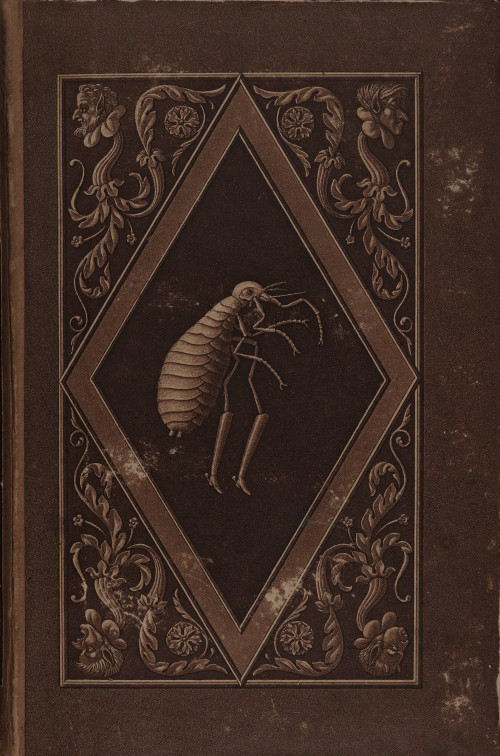 3F
3FE.T.A. HOFFMANN
Meister Floh. Ein Mährchen in sieben Abentheuern zweier Freunde. Von E.T.A. Hoffmann
Frankfurt a. M.: Wilmans 1822.
-
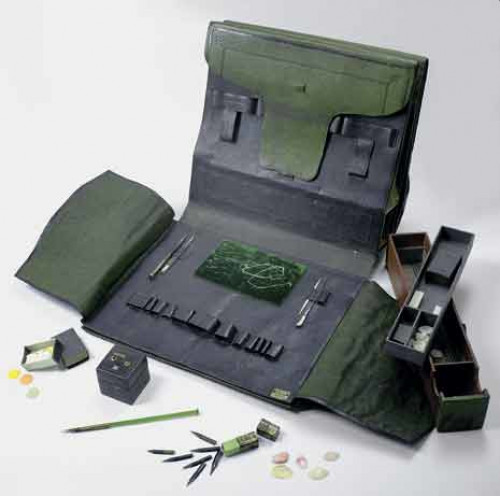 2F
2FABRAHAM MOSSNER
Im Auftrag Bettine von Arnims angefertigte Handtasche, nach 1835
-
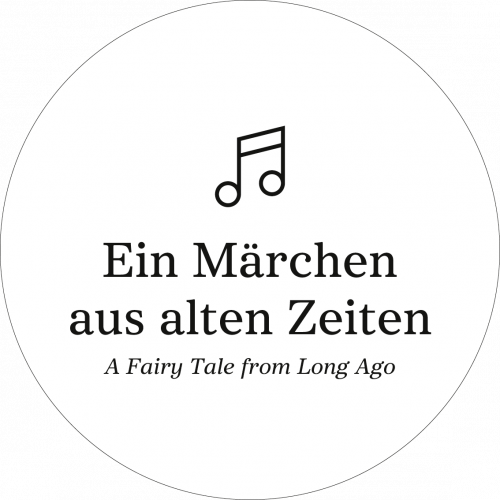 2F
2FCLARA SCHUMANN
Lorelei, 1843
Nach Heinrich Heine. Julian Prégardien (Tenor) und Michael Gees (Klavier). Live-Mitschnitt: Robert-Schumann-Gesellschaft. Frankfurt am Main, 2017.
-
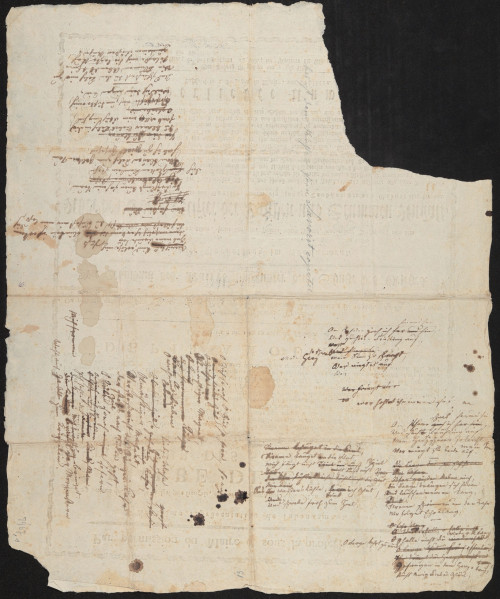 2F
2FCLEMENS BRENTANO
Am Rheine schweb ich her und hin (before June 22, 1802)
-
 3F
3FArchive
Previous exhibitions in the Manuscript Studio
-
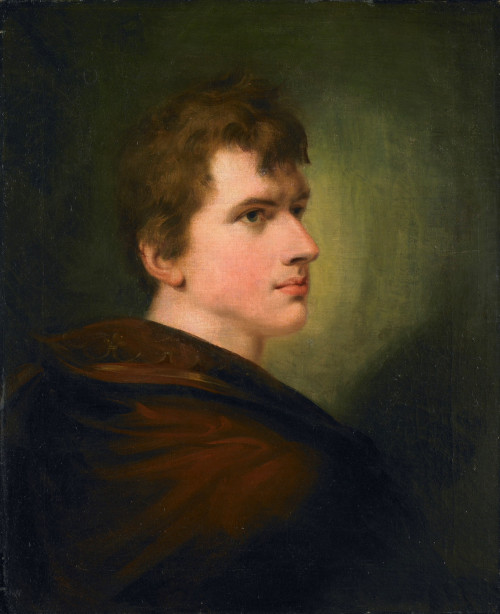 2F
2FEDUARD STRÖHLING
Achim von Arnim, 1804
-
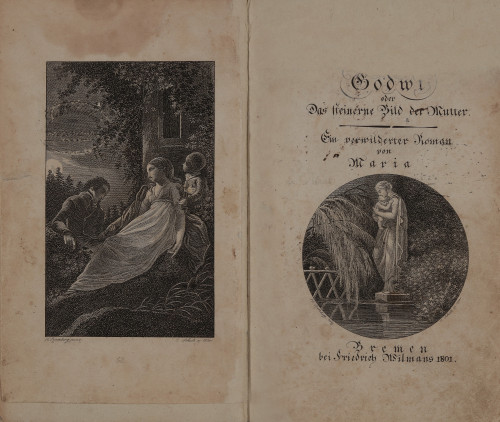 2F
2FCLEMENS BRENTANO
Godwi oder Das steinerne Bild der Mutter. Ein verwilderter Roman von Maria
2 Bände. Bremen: Wilmans 1801.
-
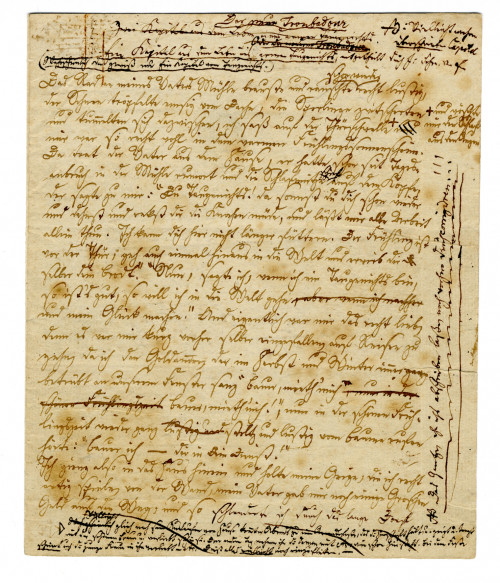 3F
3FJOSEPH VON EICHENDORFF
Der neue Troubadour. Ein Kapitel aus dem Leben eines armen Taugenichts, mitgetheilt durch J. Frhrn. v. E. (1822)
1823
-
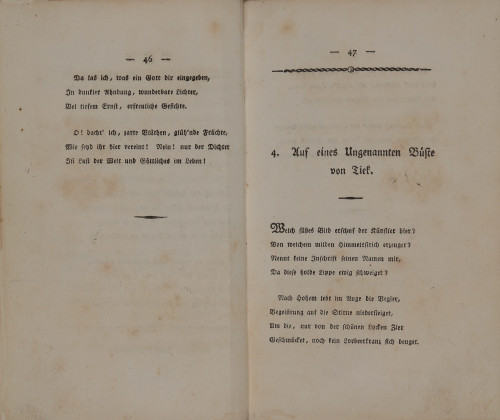 2F
2FSOPHIE MEREAU-BRENTANO
Auf eines Ungenannten Büste von Tiek
In: Bunte Reihe kleiner Schriften von Sophie Brentano. Frankfurt a. M.: Wilmans 1805, S. 47–48.
-
3F
Poster for Freischütz
Theatre poster, 1823.
-
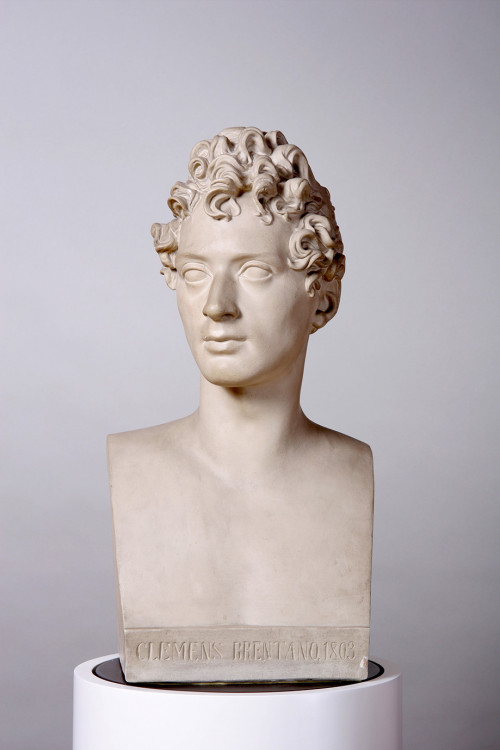 2F
2FCHRISTIAN FRIEDRICH TIECK
Porträtbüste Clemens Brentano, 1803
-
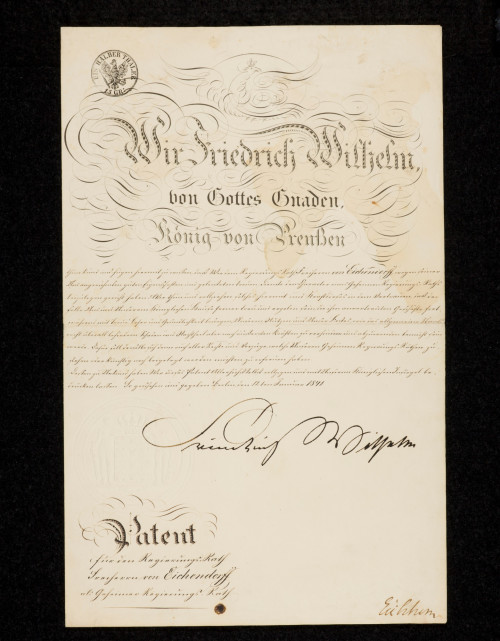 3F
3FFRIEDRICH WILHELM IV. VON PREUSSEN
Patent für den Regierungs-Rath Freiherrn von Eichendorff als Geheimer Regierungs-Rath (12. Januar 1841)
-
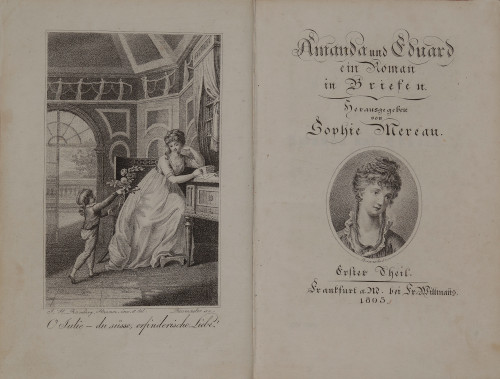 2F
2FSOPHIE MEREAU-BRENTANO
Amanda und Eduard, ein Roman in Briefen. Herausgegeben von Sophie Mereau
2 Bände. Frankfurt a. M.: Wilmans 1803.
-
3F
JOSEPH VON EICHENDORFF
Aus dem Leben eines Taugenichts. Novelle. Nachwort von Konrad Nussbächer
Stuttgart: Reclam 1970.
-
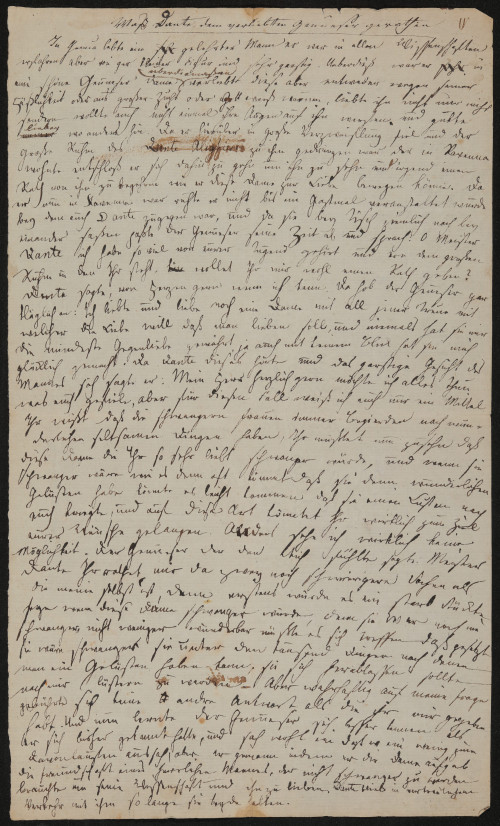 2F
2FSOPHIE MEREAU-BRENTANO
Was Dante dem verliebten Genueser gerathen, ab 1803
-
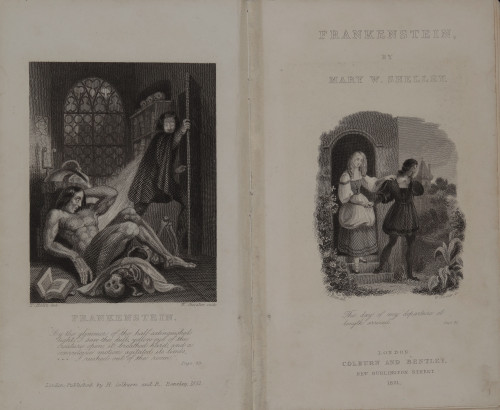 3F
3FMARY SHELLEY
Frankenstein: or, The Modern Prometheus. By the Author of The Last Man, Perkin Warbeck
Revised, Corrected, and Illustrated with a New Introduction, by the Author. London: Colburn and Bentley; Edinburgh: Bell und Bradfute; Dublin: Cumming 1831 (Bentley’s Standard Novel 9). 3. Ausgabe. Frontispiz und Titelvignette von Theodor von Holst.
-
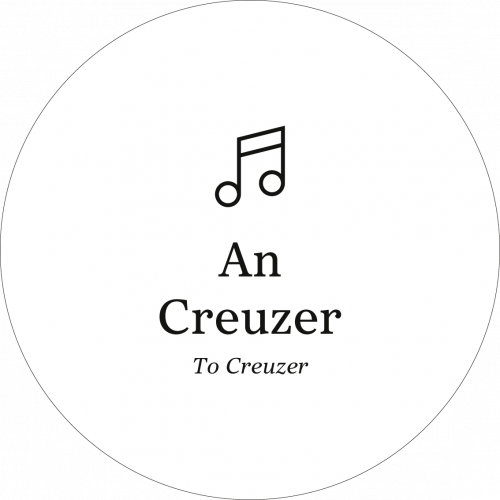
2F
WOLFGANG RIHM
An Creuzer, 1990
Aus „Das Rot. Sechs Gedichte der Karoline von Günderrode“. Clare Lesser (Sopran), David Lesser (Klavier). Metier 2013
-
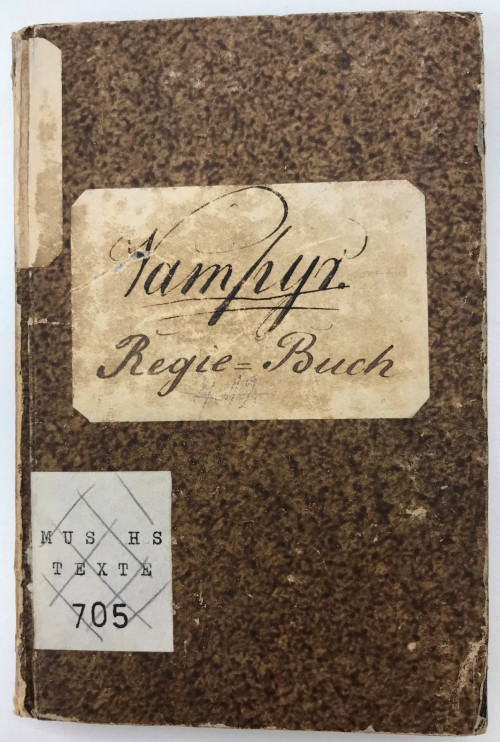 3F
3FHEINRICH MARSCHNER
Der Vampyr. Romantische Oper in zwei Aufzügen. Nach Lord Byron’s Erzählung frei bearbeitet von Wilh. Aug. Wohlbrück, Regisseur des Magdeburger Theaters. In Musik gesetzt von Heinrich Marschner, Königl. Sächsischem Musik-Direktor
Leipzig: Hartmann 1828.
-
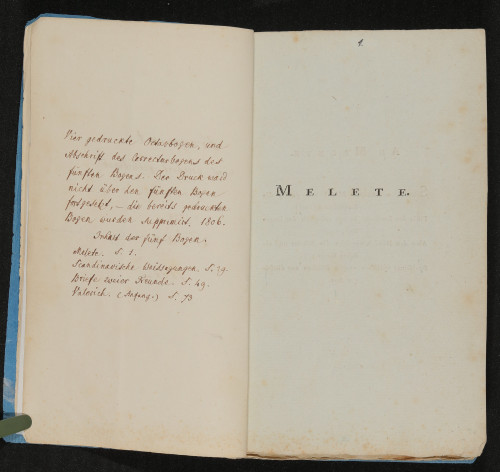 2F
2FKAROLINE VON GÜNDERRODE
Melete, 1806
-
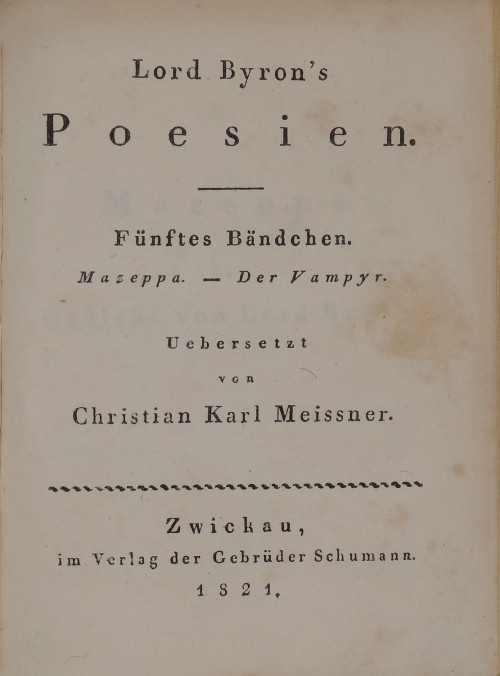 3F
3FJOHN WILLIAM POLIDORI
Lord Byron’s Poesien. Fünftes Bändchen. Mazeppa. – Der Vampyr
Zwickau: Schumann 1821.
-
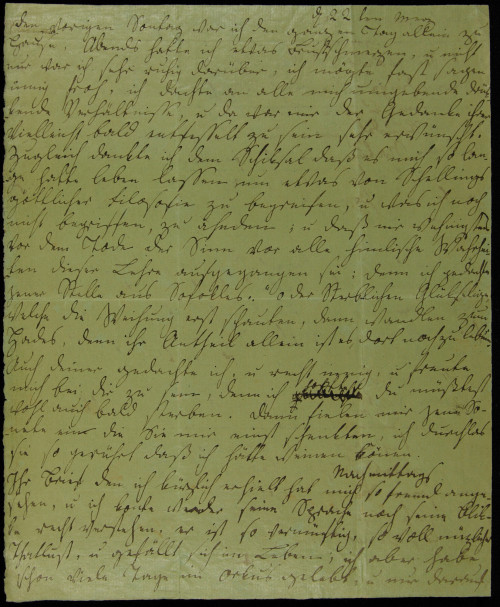 2F
2FKAROLINE VON GÜNDERRODE
Letter to Friedrich Creuzer, Frankfurt a. M., March 22, 1805
-
 2F
2FSchnürriemen
-
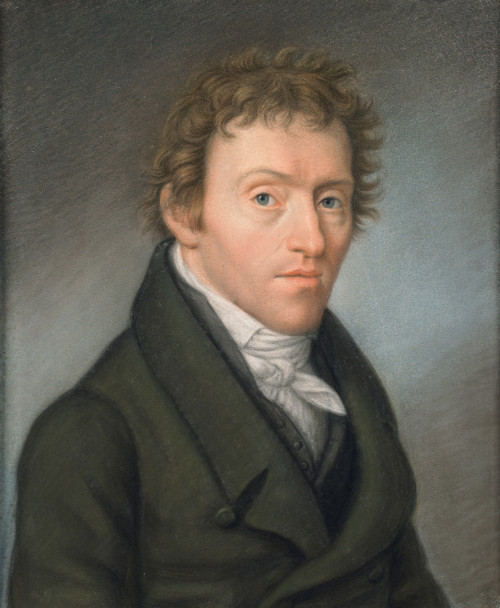 2F
2FJACOB WILHELM CHRISTIAN ROUX
Friedrich Creuzer, um 1820
-
2F
HEINRICH VON KLEIST
Letter to Wilhelmine von Zenge, Thun, May 20, 1802
-
2F
KAROLINE VON GÜNDERRODE
Edle Freundschaft nur verbindet, 1794
-
 2F
2FCHRISTA WOLF
Kein Ort. Nirgends
Berlin, Weimar: Aufbau-Verlag 1979. Darmstadt, Neuwied: Luchterhand 1979.
-

3F
LOUIS FERDINAND PRINZ VON PREUSSEN
Larghetto G-Dur, Op. 11, 1806
Göbel-Trio Berlin. Thorofon 1990
-
 2F
2FPHILIPP OTTO RUNGE
The Times of Day. Morning, Evening, Day, Night
-
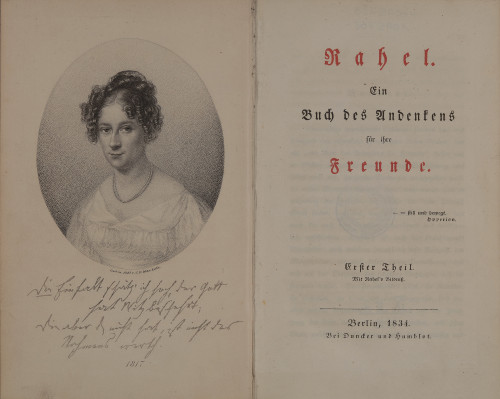 3F
3FRAHEL VARNHAGEN
Rahel. Ein Buch des Andenkens für ihre Freunde
Teil 1 (von 3). Berlin: Duncker und Humblot 1834. – Frontispiz (Stahlstich in Punktmanier) von Carl Eduard Weber nach Moritz Michael Daffinger, darunter Rahel Varnhagens faksimilierte Handschrift: „Die Einfalt schätz’ ich hoch, der Gott / hat Witz bescheh
-
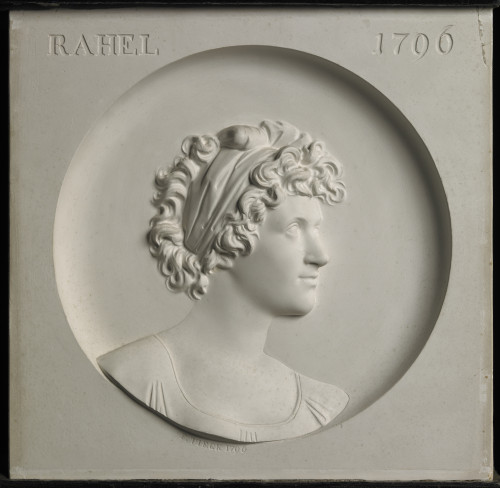 3F
3FCHRISTIAN FRIEDRICH TIECK
Rahel 1796 (1835)
-
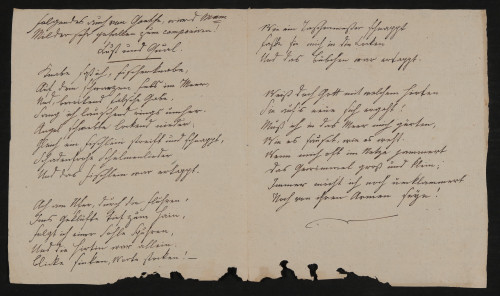 3F
3FRAHEL VARNHAGEN
Copy of two poems by Goethe, nach 1820
S. 1: Merz („Es ist ein Schnee gefallen“), S. 2: Lust und Qual („Knabe saß ich, Fischerknabe“) mit der Anmerkung: „Folgendes auch von Goethe, wird Mam Milder sehr gefallen zum componiren!“, auf S. 4 von unbekannter Hand: „Rahels Hands
-
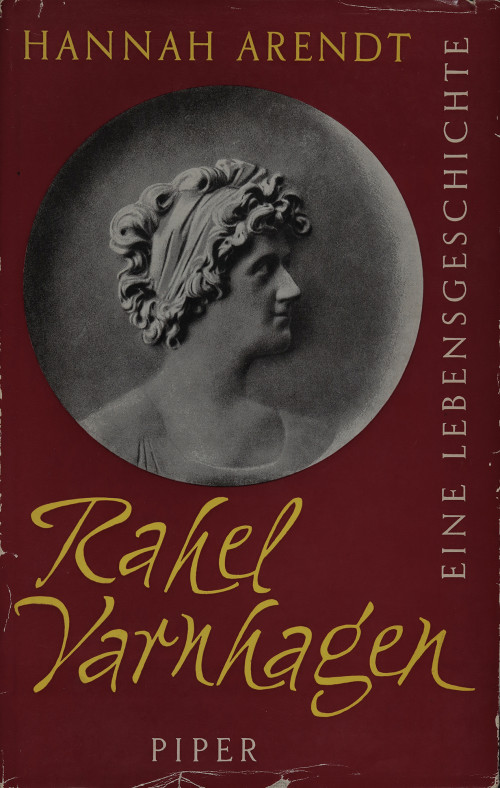 3F
3FHANNAH ARENDT
Rahel Varnhagen. Lebensgeschichte einer deutschen Jüdin aus der Romantik. Mit einer Auswahl von Rahel-Briefen und zeitgenössischen Abbildungen.
München: Piper 1959.
-
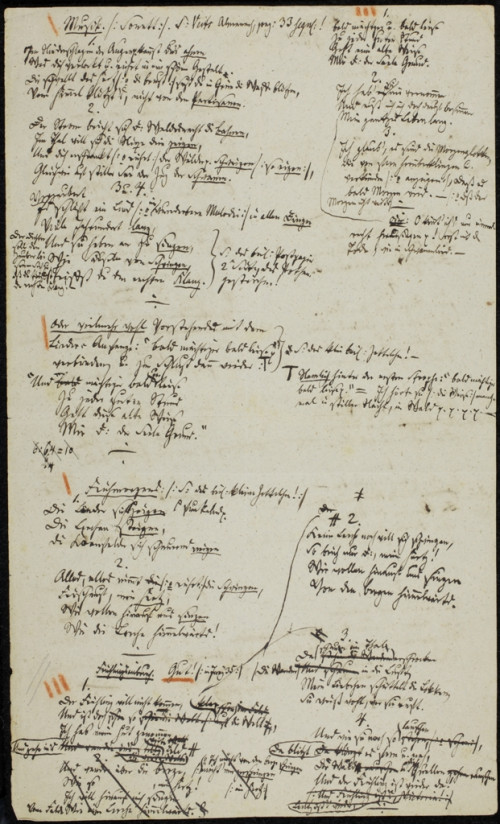 3F
3FJOSEPH VON EICHENDORFF
Drafts of various poems, 1835
-
2F
FRIEDRICH SCHLEGEL
Would it not be more correct to place π [poetry] at the centre? (1802/03)
-
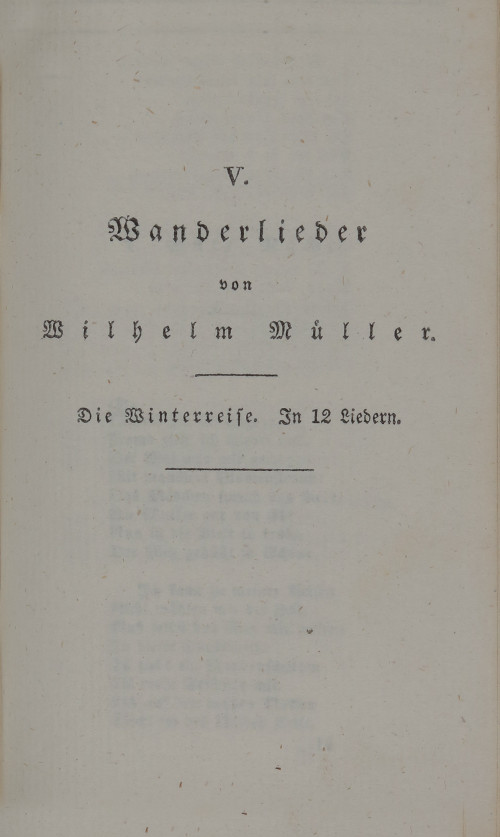 3F
3FWILHELM MÜLLER
Urania. Taschenbuch auf das Jahr 1823
Neue Folge, 5. Jahrgang. Leipzig: Brockhaus 1823. Darin: Wanderlieder von Wilhelm Müller. Die Winterreise. In 12 Liedern, S. 207‒222.
-
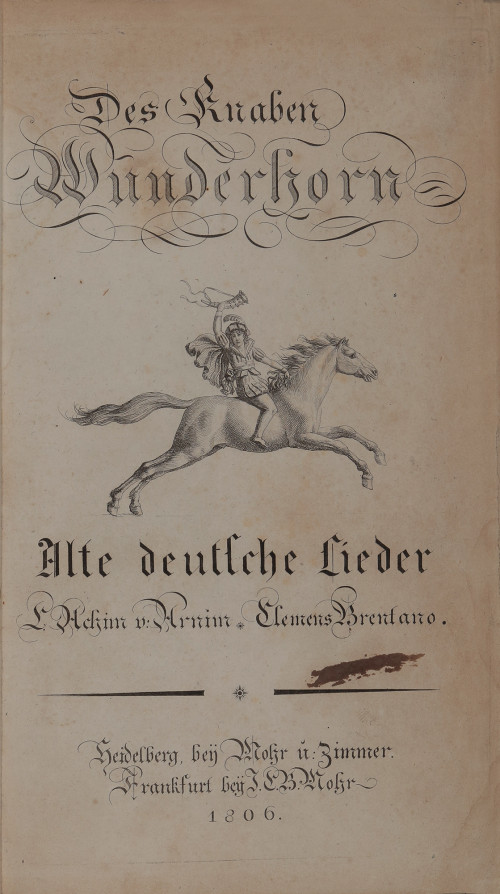 2F
2FACHIM VON ARNIM, CLEMENS BRENTANO
Des Knaben Wunderhorn. Alte deutsche Lieder gesammelt von L. A. v. Arnim und Clemens Brentano
(Band 1.) Heidelberg: Mohr und Zimmer; Frankfurt a. M.: Mohr 1806. Band 2. Heidelberg: Mohr und Zimmer 1808.
-
 3F
3FWILHELM MÜLLER
Gedichte aus den hinterlassenen Papieren eines reisenden Waldhornisten. Herausgegeben von Wilhelm Müller
Band 2. Dessau: Ackermann 1824. Darin: Die Winterreise, S. 75–108.
-
 2F
2FGEORGE AUGUSTUS WALLIS
Das Heidelberger Schloss unter doppeltem Regenbogen, 1812
-
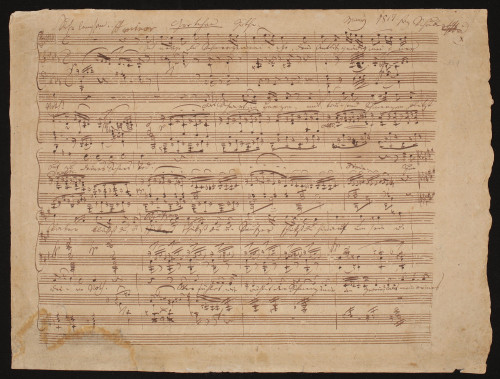 3F
3FFRANZ SCHUBERT
Gretchen Göthe, May 1817
-
 2F
2FCLEMENS BRENTANO
Letter to Johann Georg Zimmer, Kassel, January 25, 1808
-
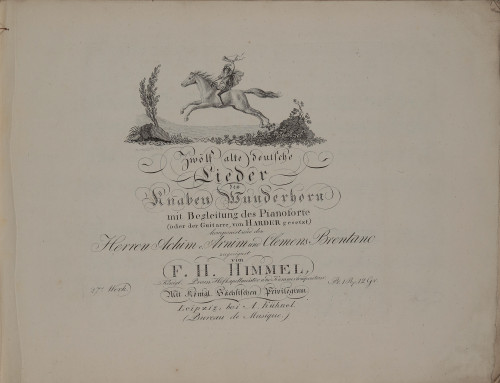 2F
2FFRIEDRICH HEINRICH HIMMEL
Zwölf alte deutsche Lieder des Knaben Wunderhorn mit Begleitung des Pianoforte (oder der Guitarre, von Harder gesetzt) komponirt und den Herren Achim v. Arnim und Clemens Brentano zugeeignet von F. H. Himmel
Leipzig: Kühnel 1808.
-
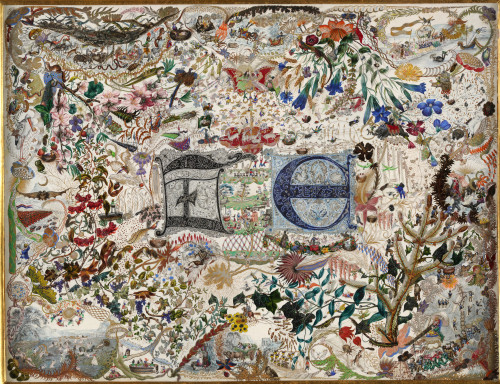 3F
3FARMGART VON ARNIM
Oberon und Titanias Feenhuldigung, 1843
-
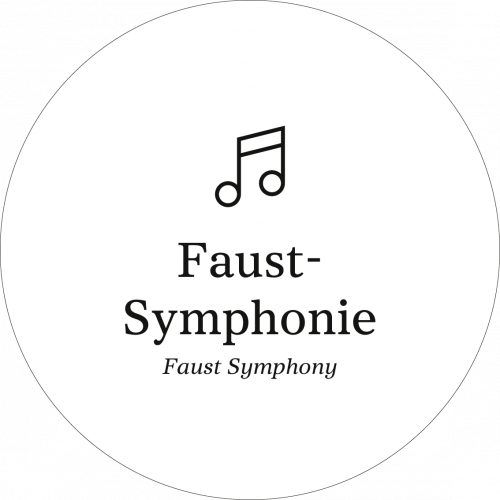
2F
FRANZ LISZT
Faust Symphony, 1854–1857
Ausschnitte aus Faust (1. Satz), Gretchen (2. Satz), Mephistopheles (3. Satz). Klaus König (Tenor), Gewandhausorchester Leipzig. Leitung: Kurt Masur. Eterna 1981
-
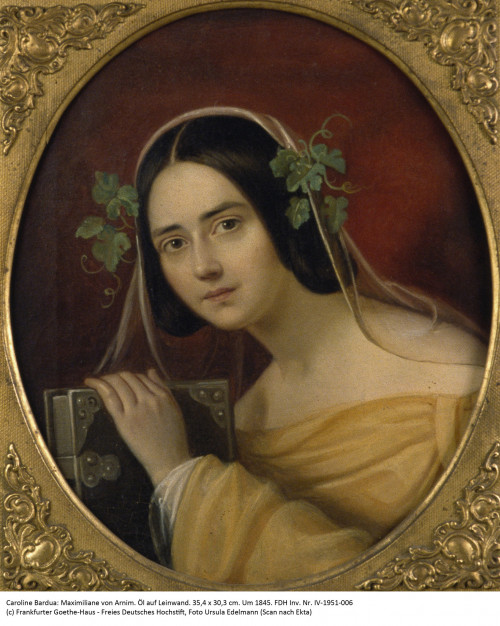 3F
3FCAROLINE BARDUA
Maximiliane von Arnim; Armgart von Arnim; Gisela von Arnim (um 1840/43)
-
 2F
2FJOHANN WOLFGANG VON GOETHE
Faust. Eine Tragödie. von Goethe
Tübingen: Cotta 1808.
-
3F
GISELA VON ARNIM / HERMAN GRIMM
Liebe überwindet Kartoffelbrei. Freßmärchen von Carl Anbiss (vor dem 10. Juni 1843)
-
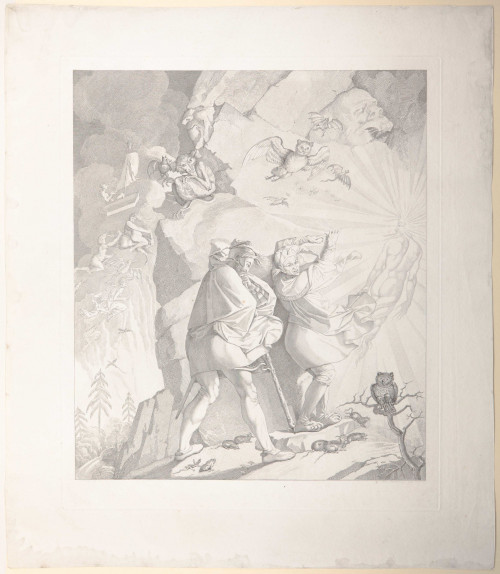 2F
2FPETER CORNELIUS
Bilder zu Göthe’s Faust, 1816‒1826
-
3F
BETTINE VON ARNIM
Nachweis der verarmten und hülfsbedürftigen Personen und Weber-Familien bei der Gemeinde Dittmannsdorff Waldenburger Kreises, 8. März 1844
-
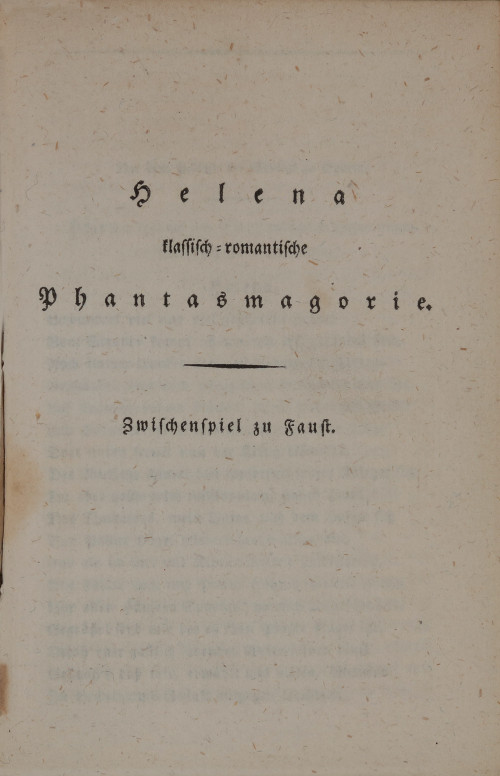 2F
2FJOHANN WOLFGANG VON GOETHE
Helena klassisch-romantische Phantasmagorie. Zwischenspiel zu Faust
In: Goethe’s Werke. Vollständige Ausgabe letzter Hand. Band 4. Stuttgart und Tübingen: Cotta 1827, S. 229‒307.
-
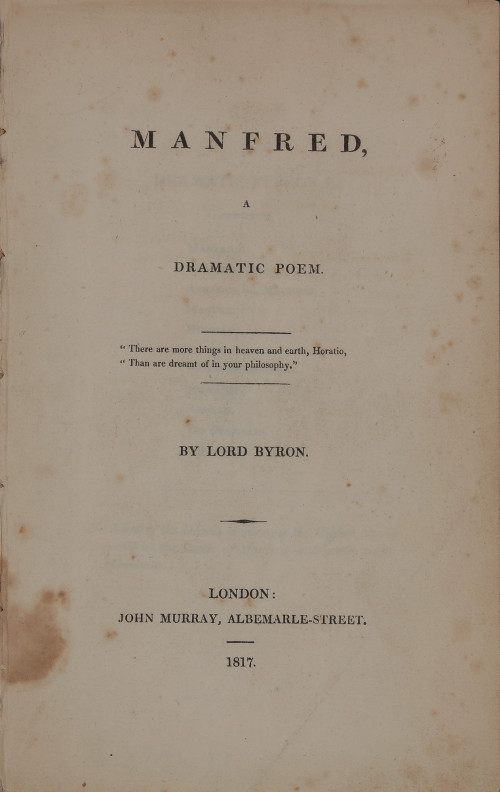 2F
2FGEORGE GORDON BYRON
Manfred, A Dramatic Poem. By Lord Byron
London: Murray 1817.
-
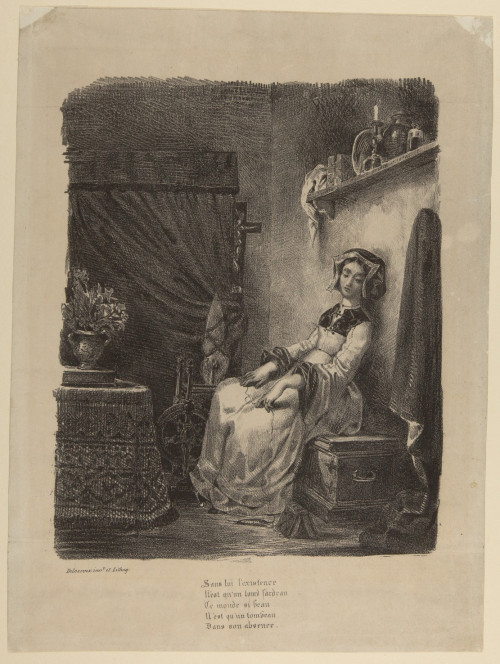 2F
2FEUGÈNE DELACROIX
Illustrations to Goethe's Faust
In: Faust, Tragédie de M. de Goethe, traduite en français par M. Albert Stapfer, Ornée d’un Portrait de l’Auteur, et de dix-sept dessins composés d’après les principales scènes de l’ouvrage et éxécutés sur pierre par M. Eugène Delacroix
-
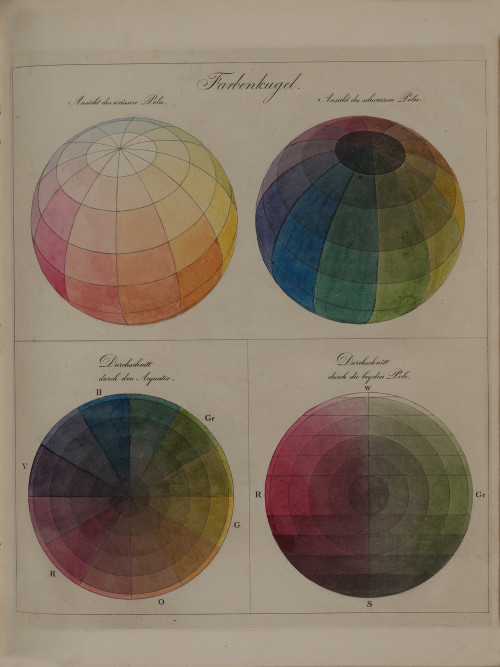 2F
2FPHILIPP OTTO RUNGE
Farben-Kugel oder Construction des Verhältnisses aller Mischungen der Farben zu einander, und ihrer vollständigen Affinität, mit angehängtem Versuch einer Ableitung der Harmonie in den Zusammenstellungen der Farben. Von Philipp Otto Runge, Mahler. Nebst e
Hamburg: Perthes 1810.
-
2F
JOHANN WOLFGANG VON GOETHE
Wheel in watercolours, 1809
-
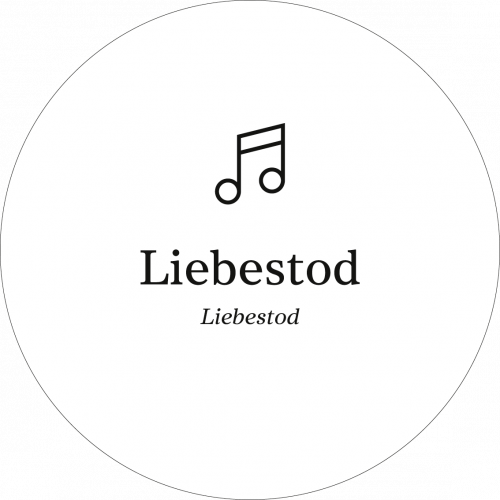
3F
RICHARD WAGNER
Tristan und Isolde, 1857‒1859
Ausschnitt aus dem Liebesgespräch des 2. Aufzugs. Waltraud Meier (Sopran), Siegfried Jerusalem (Tenor). Berliner Philharmoniker, Leitung: Daniel Barenboim. Teldec 1995
-
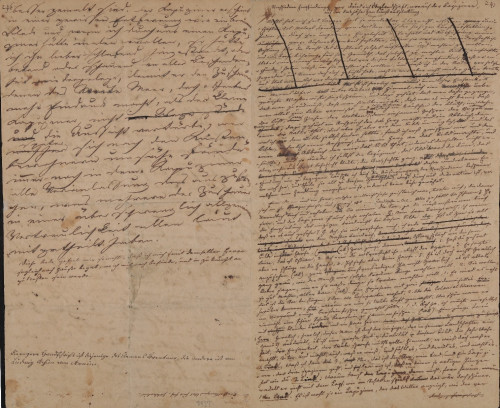 2F
2FCLEMENS BRENTANO, ACHIM VON ARNIM
Verschiedene Empfindungen vor Friedrichs Seelandschaft, worauf der Kapuziner, auf der diesjährigen Kunstausstellung (vor dem 13. Oktober 1810)
-
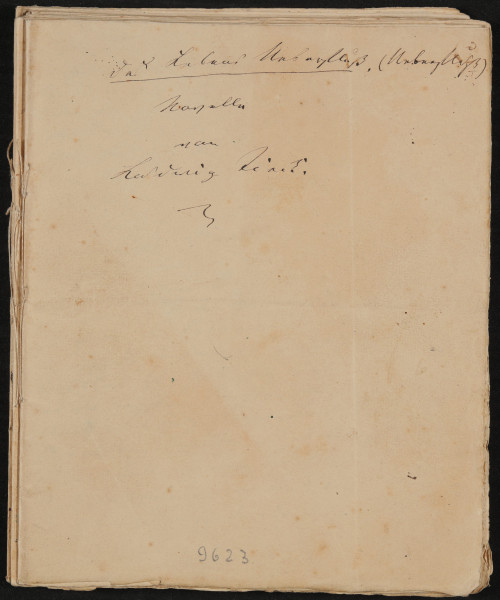 3F
3FLUDWIG TIECK
Des Lebens Überfluß. (Überfluß) | Novelle von Ludwig Tieck (Summer 1837)
-
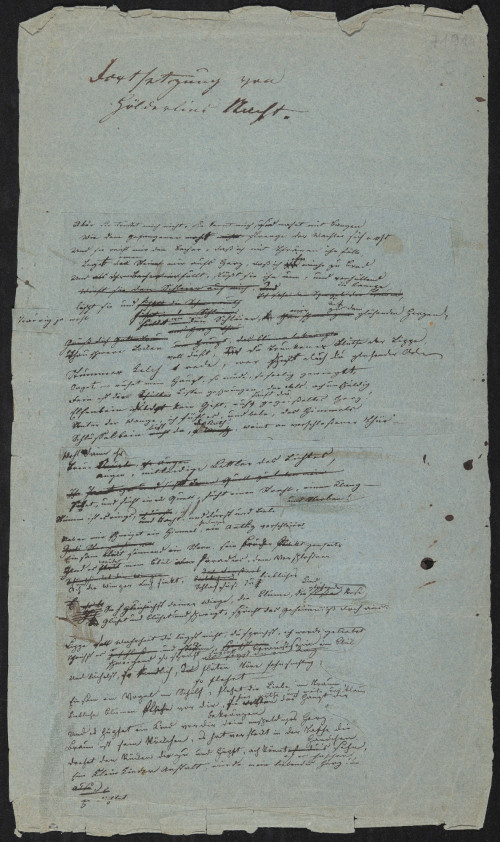 2F
2FCLEMENS BRENTANO
Fortsetzung von Hölderlins Nacht, 1834
-
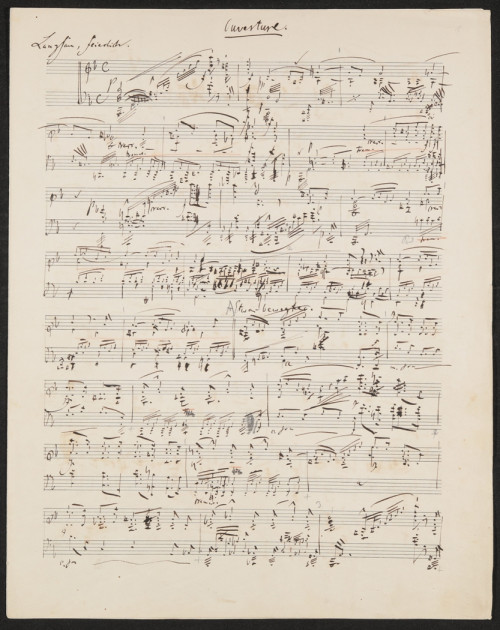 3F
3FROBERT SCHUMANN
Sketches for Faust, 1844‒1853
-

2F
WOLFGANG AMADEUS MOZART
Adagio for Glass Harmonika, 1791
Wiener Glasharmonika-Duo (Christa and Gerald Schönfeldinger) 2009
-
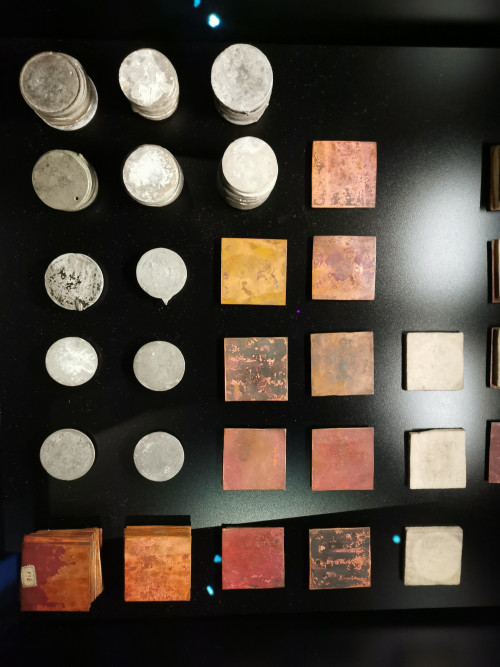 2F
2FJOHANN WILHELM RITTER
Elemente einer Batterie
-
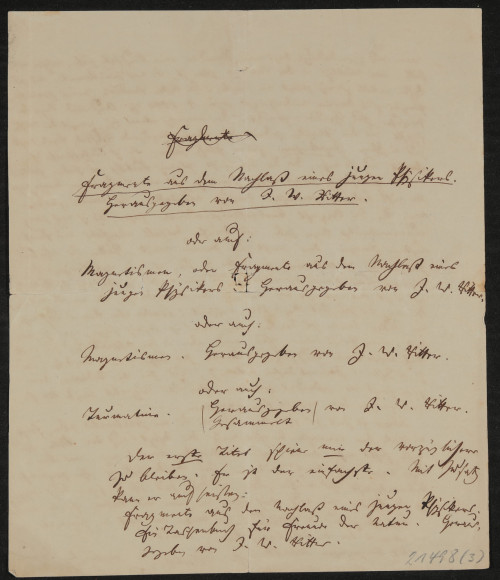 2F
2FJOHANN WILHELM RITTER
Letter to Johann Georg Zimmer, February 20, 1809
-
2F
JOHANN WILHELM RITTER
Letter to Clemens Brentano, April 9 or 10, 1802
-
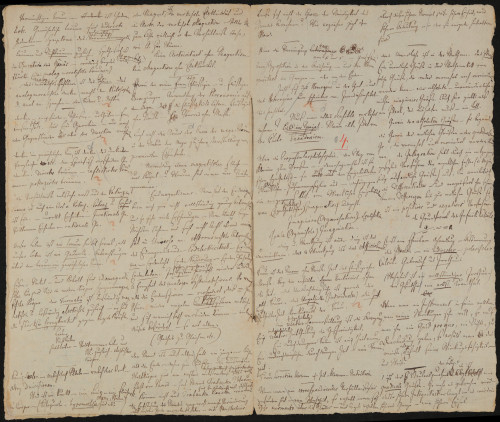 2F
2FFRIEDRICH VON HARDENBERG (NOVALIS)
Freiberger naturwissenschaftliche Studien, 1798‒99
Großes physikalisches Studienheft. S. 6‒7.
-
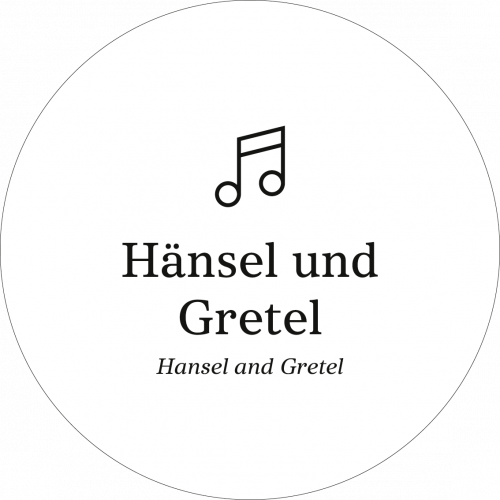
2F
ENGELBERT HUMPERDINCK
Hansel and Gretel, 1890‒1893
2. Akt: Abends will ich schlafen gehn. Ann Murray (Hänsel), Edita Gruberová (Gretel). Staatskapelle Dresden, Leitung: Sir Colin Davis. Decca 1992
-
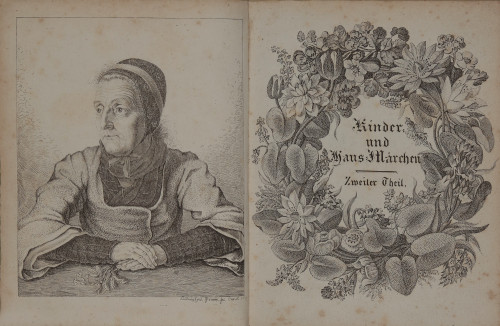 2F
2FJacob and Wilhelm Grimm
Kinder- und Hausmärchen. Gesammelt durch die Brüder Grimm
Berlin: Realschulbuchhandlung 1812.
-
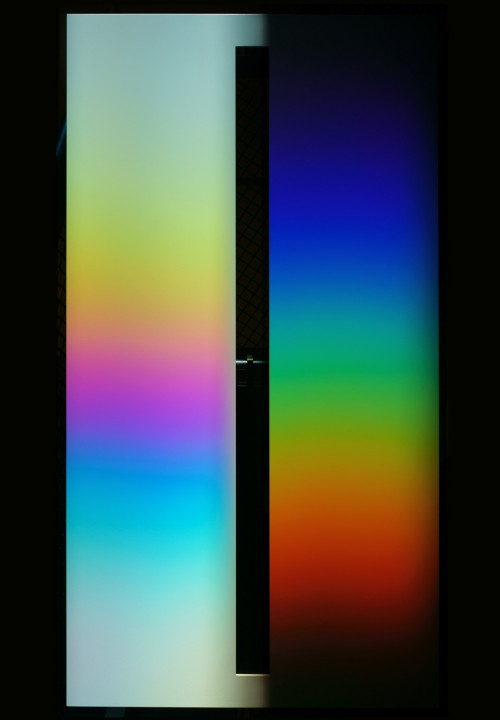 3F
3FLight installation
-
 2F
2FJACOB GRIMM und WILHELM GRIMM
German Popular Stories, Translated from the Kinder und Haus Märchen, collected by M. M. Grimm, From Oral Tradition
London: Baldwyn 1823.
-
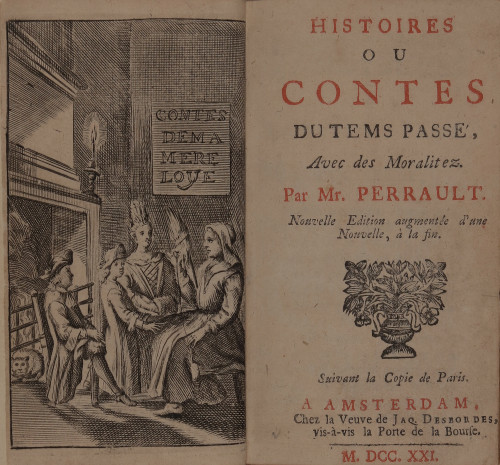 2F
2FCHARLES PERRAULT
Histoires ou Contes du tems passé, Avec des Moralitez. Par Mr. Perrault
Nouvelle Edition augmentée d’une Nouvelle (L’Adroite Princesse), à la fin. Amsterdam: La veuve Desbordes 1721. – Titelkupfer Contes de ma mere loye (Geschichten von meiner Mutter, der Gans) nach Antoine Clouzier.
-
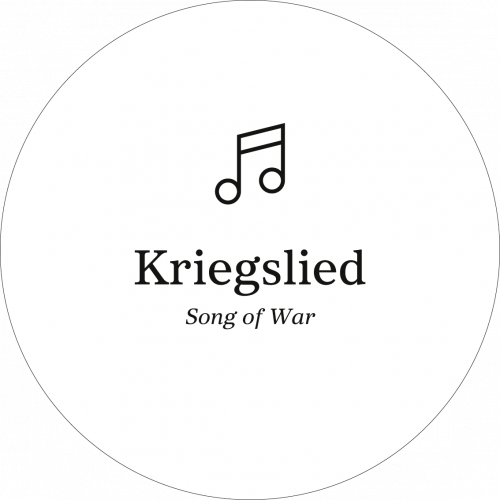
2F
JUSTIN LÉPANY
Germania an ihre Kinder für 3 Frauenstimmen (Ausschnitt), 2011
Lotta Hultmark (Sopran), Kristina Elfversson (Sopran) und Sabine Eyer (Alt) 2011
-
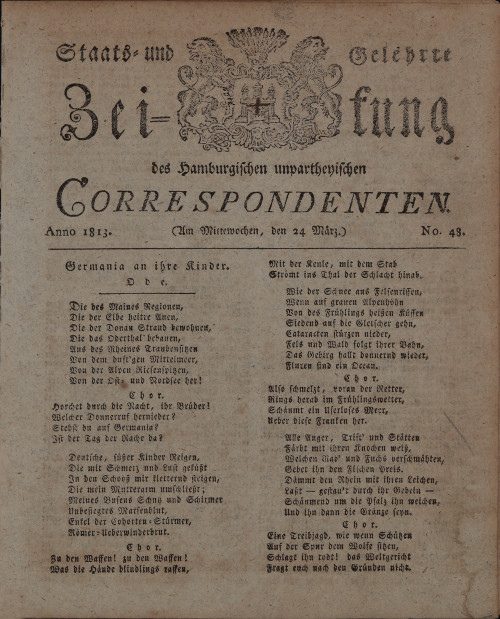 2F
2FHEINRICH VON KLEIST
Germania an ihre Kinder. Ode
In: Staats- und Gelehrte Zeitung des Hamburgischen unpartheyischen Correspondenten Nr. 48 vom 24. März 1813, S. 1‒2.
-
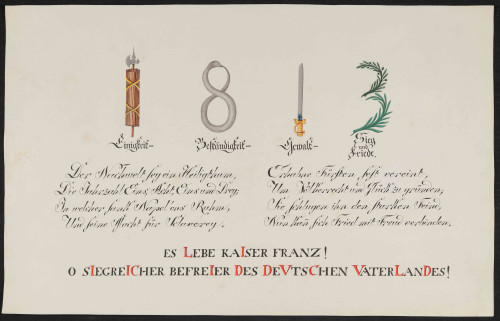 2F
2FFRANZ-XAVER MILLER
1813. Einigkeit – Beständigkeit – Gewalt – Sieg und Friede
Gratz: Miller 1814.
-
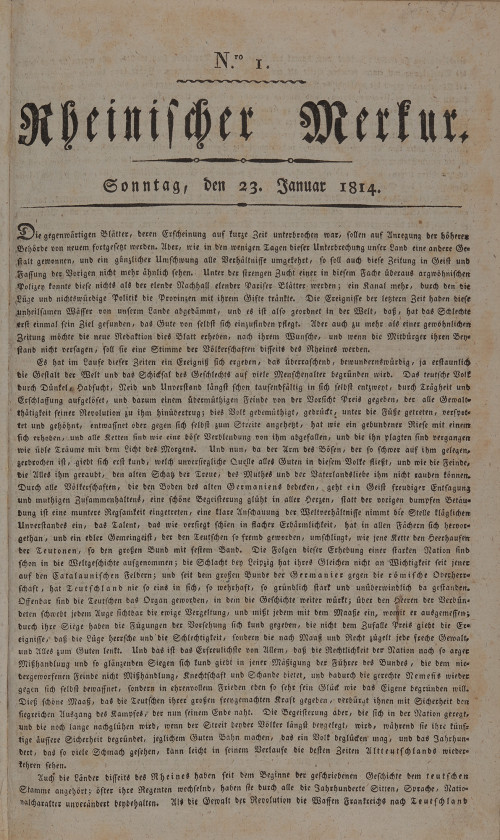 2F
2FJOSEPH GÖRRES
Vorwort zum Rheinischen Merkur
In: Rheinischer Merkur Nr. 1 vom 23. Januar 1814. Koblenz: Heriot, S. 1‒2.
-
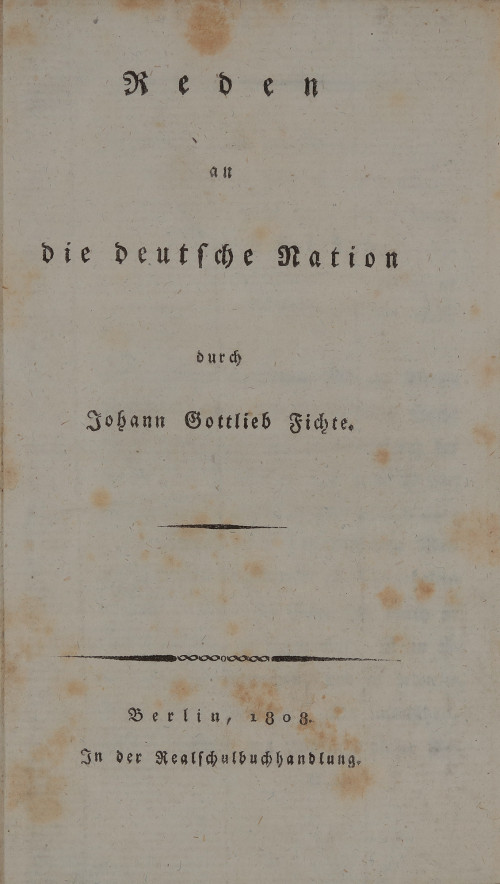 2F
2FJOHANN GOTTLIEB FICHTE
Reden an die deutsche Nation durch Johann Gottlieb Fichte
Berlin: Realschulbuchhandlung 1808.
-
 2F
2FERNST MORITZ ARNDT
Blick aus der Zeit auf die Zeit. Von E.M. Arndt
Germanien (d.i. Frankfurt a.M.) 1814 (erschienen: 1815).
-
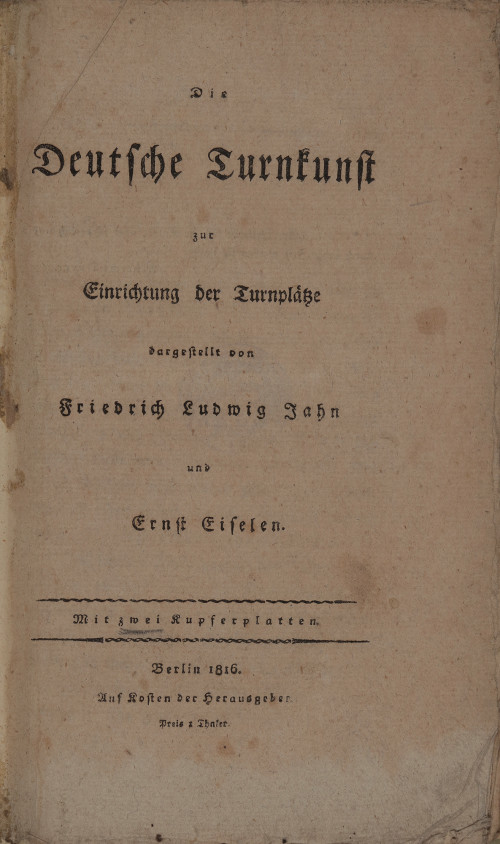 2F
2FFRIEDRICH LUDWIG JAHN UND ERNST EISELEN
Die Deutsche Turnkunst zur Einrichtung der Turnplätze dargestellt von Friedrich Ludwig Jahn und Ernst Eiselen
Berlin: Selbstverlag 1816.
-
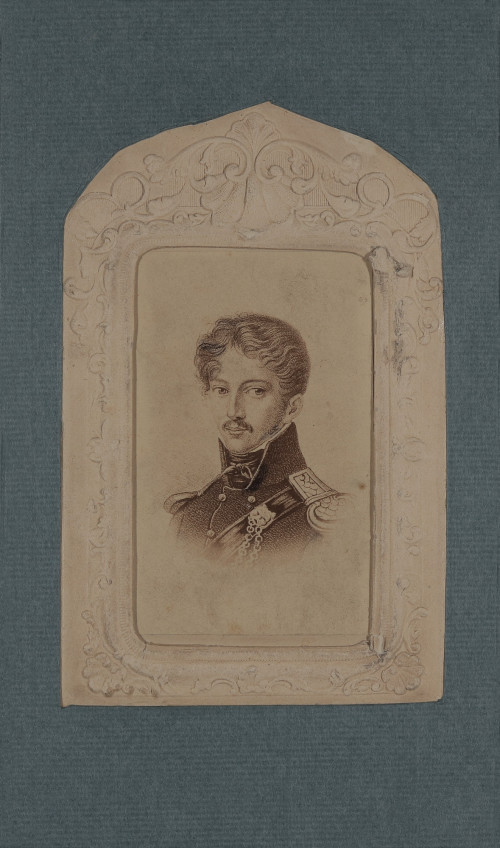 2F
2FTHEODOR KÖRNER
Zwölf freie deutsche Gedichte von Theodor Körner
Leipzig 1813.
-
 2F
2FJOHANN MICHAEL VOLTZ
Triumph des Jahres 1813. Den Deutschen zum Neuenjahr 1814
Berlin: Henschel 1814.
-
 2F
2FRUDOLF ZACHARIAS BECKER
Das deutsche Feyerkleid zur Erinnerung des Einzugs der Deutschen in Paris am 31sten März 1814 eingeführt von deutschen Frauen
Gotha: Becker 1814.
-
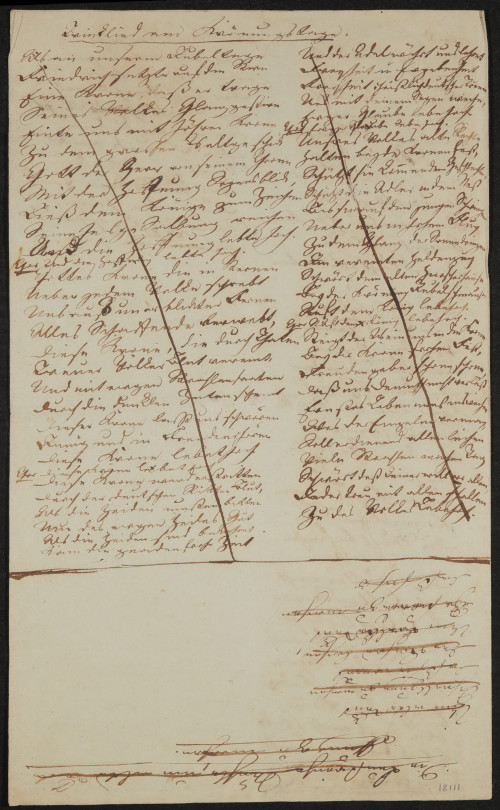 2F
2FACHIM VON ARNIM
Trinklied am Krönungstage (vor dem 18. Januar 1811)
-
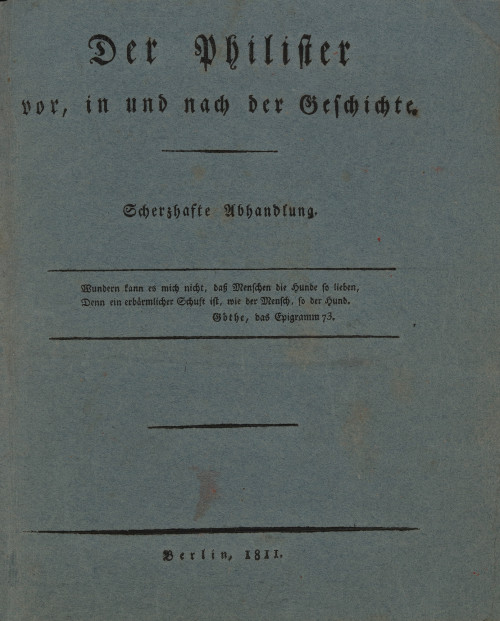 2F
2FCLEMENS BRENTANO
Der Philister vor, in und nach der Geschichte. Scherzhafte Abhandlung
Berlin 1811.